


































Gunn’s Student Executive Council will hold its first Spring Homecoming Week, known as SPROCO, from March 12-15.
In contrast to past spring spirit weeks, which have usually included schoolwide dress-up themes and lunch activities, SPROCO will be similar to Homecoming Week, with daily grade-specific dress-up themes and games during brunch, lunch and PRIME.
Some brunch and lunch games — such as Balloon Stomp, in which participants attempt to pop as many of their opponents’ balloons as possible — are repeats from Homecoming Week activities. Others, such as Obstacle Course and Pool Relay, will be reworked versions of their Homecoming Week counterparts. The week will
also feature completely new events: In Pizza Noodles, competitors will hold a pizza box in their palm while trying to knock others’ boxes off with a foam pool noodle.
According to organizer senior Chris Lee, school board representative and managing editor for The Oracle , SPROCO emerged from an SEC impact project, in which SEC members create a new event, initiative or system that benefits the student body. Senior Class Vice President Naya Nebriaga is also on the SPROCO team and has high hopes for student engagement.
“Because seniors tied (during Homecoming Week) this year, I think that was more of a driving force to make (SPROCO) actually happen,” she said.
SEC created a reveal video for SPROCO, released during PRIME on Feb. 28. The video featured Lee and Nebriaga in a flashback to October’s Homecoming Week and teased some grade-specific themes — including “Homecoming
Deja Vu,” in which the dress-up for each grade is pulled from October’s homecoming.
“At first, it was difficult coming up with an idea because we’re not revealing a theme — we’re revealing the week itself,” Lee said. “But I actually think that worked out better in the long run because we were able to start from a blank slate and have a more creative plot.”
Through this reveal video — past ones have helped publicize schoolwide events — Instagram posts and posters around campus, SEC hopes to increase and participation.
Beyond SEC, students are looking forward to participating in the new spirit week. Freshman Audrey Berger hasn’t experienced major spirit events other than Homecoming Week and anticipates enjoying SPROCO.
“I’ve heard that (SPROCO) wasn’t really a strong tradition until this year, and I think it’s really cool that as a freshman, I get to experience that,” she said.
In 2017, Gunn implemented the Social-Emotional Literacy and Functionality program in response to growing concerns about student mental health on campus and new California social-emotional learning standards.
This program is the first of the wellness initiatives The Oracle will be investigating in a continuation of its 2019 “In the Pursuit of Wellness” series. The objective is to better understand the efficacy of Gunn studentwellness approaches. Our question: Are these measures working, and how can we further promote student wellness?
Intended as a space for students to build connections with trusted adults and peers, SELF classes meet biweekly — in rotation with Study Hall — during the
school year. This model, adopted during the 2022-23 school year due to teacher compensation issues, marks a shift from the program’s original weekly structure. As before, however, cohorts remain together during all four years of high school.
I say a lot of students don’t really recognize SELF for what it’s trying to be. There’s a lot of antagonizing it because people don’t see what the creators are trying to do with it.
Freshman
SELF Coordinator Kathryn Catalano noted that the program’s goal is to promote students’ emotional regulation, communication and empathy. Its curriculum is based on California’s Social and Emotional Learning Competencies, or the T-SEL Competencies, which include
self-awareness, social-awareness and relationship skills. Gunn’s SELF curriculum also draws on sources such as private-school curricula; Project Wayfinder, an organization that provides packaged grade-specific SEL curricula to schools; Stanford professor Linda Darling-Hammond, a social scientist who advised the curriculum’s development in 2016; student organizations such as the Gender Sexuality Alliance and Title IX Club; and proposals from individual students.
Currently, SELF is designed to suit different grades’ needs. For example, ninth graders begin with lessons on “Founding a Community,” which includes identity development and community-building, while secondsemester seniors focus on “Life after Gunn.”
According to Assistant Principal and former SELF Coordinator Courtney Carlomagno, the SELF curriculum constantly evolves based on feedback from feedback forms, focus groups, administrators and SELF Advisory Board students (whose names students can see on the SELF feedback form in the Schoology
On March 9, students will begin taking the SAT in a new adaptive digital format, a shift that will reshape the standardized-testing landscape for millions of high school students.
The new exam will be taken on a student’s or a schoolissued device, and will be partitioned into two — rather than the current three — sections: Reading and Writing, and Math. The test will also be 46 minutes shorter.
I’m not a fan of the digital SAT because I feel like I’ve already spent time preparing for the paper one, and having it suddenly switch to digital means I have to adapt to a new system.
Junior Sophia HeThis change follows a 2021 pilot project conducted by the College Board, which showed that a digital SAT was less stressful for 80% of students in comparison to its pencil-and-paper counterpart. The current paper SAT will no longer be offered starting March 9.
The test will also be adaptive, meaning students’ performance on the first set of questions affects the difficulty of the following set. Difficult problems that are correctly answered will yield higher scores than easier questions, though the final score will still be out of 1600.
Given these changes, students who have spent time preparing for the print exam, such as sophomore Archer Jin, have had to alter their study habits.
“I’d rather do the old type because everything I’ve practiced is related to that,” Jin said.
Junior Sophia He echoed Jin’s sentiments.
“I’m not a fan of the digital SAT because I feel like I’ve already spent time preparing for the paper one, and having it suddenly switch to digital means I have to adapt to a new system,” she said.
Still, Assistant Principal of Testing Rebecca ShenLorenson noted that the SAT is just one of many exams going digital, and students taking the exam during their junior year will already have had practice with the digital PSAT — administered for the first time in October 2023.
“I’m hoping that moving from paper and pencil is actually going to be more effective and advantageous for students,” she said.
Because students are allowed to bring their own devices to the exam, however, some have expressed concerns about academic honesty. Shen-Lorenson doubts that cheating will be an issue, especially
1. Pace yourself
2. Use the Bluebook testing app’s annotation feature
3. Don’t rely on answer choice probability
4. Don’t leave questions blank
5. Feel free to move around within each module
6. Do your best
7. Learn how to use the built-in Desmos tool
8. Take a full-length practice test on Bluebook
9. Focus your practice where you need it
10. Get a good night’s sleep and eat a good breakfast
Source: College Board
considering that students will receive different adaptive questions. Additionally, according to the SAT Terms and Conditions on the College Board website, violation of any policies related to test security can result in a dismissal from the test center, a score cancellation or a test-taking ban, depending on the severity of the offense.
Just take a deep breath. Remember that you’re trying your best and if this is your first time taking the SAT, look at it as your first experience (for) what to expect next time.
Assistant Principal of Testing Rebecca ShenLorenson
Although many students believe that their performance on the SAT will decide their future, Shen-Lorenson urges them to consider the larger picture.
“For the SAT, (students) should not put too much pressure on themselves because it is only one point of reference for universities,” she said. “Just take a deep breath. Remember that you’re trying your best and if this is your first time taking the SAT, look at it as your first experience (for) what to expect next time.”

Are you planning on taking the digital SAT?
Not sure
I already took the SAT I am not taking any standardized test I am taking a non-SAT standardized test
Source: Self-selected survey sent out to Gunn students by The from Feb. 25 to March 4 with 119 responses

780 Arastradero Rd. Palo Alto, CA 94306 (650) 354-8238 www.gunnoracle.com
Editorial Board
Editor-in-Chief Amann Mahajan
Managing Editors
Chris Lee
Irene Tsen
News
Victor Dang
Michelle Koo
Charlotte Qian
Forum
Anne Dong
Annabel Honigstein
Jeffrey Kang
Features
Diya Bose-Malakar
Kaylee Cheng
Safina Syed
Centerfold
Maddie Cheung
Lise Desveaux
In-Depth
Dan Honigstein
Becca Wu
Sports
Yueun Hong
Katie LaWer
Vivian Studdert
Lifestyle
Kaitlyn Chen
Vivien Chen
Bryan Xiao
Online
Sophia Hwangbo
Fiona Xiong
Social Media
Zoe Leontis
Ya-An Xue
Ellie Yuan
Graphics Editor
Irene Hong
Photos Editor Chinyoung Shao
Staff
Business/Circulation
Sylvie Nguyen
Bryan Xiao
Oracle-SEC Liaison
Safina Syed
Graphics Artists Vin Bhat
Emma Cao
Aarushi Kumar
Natalie Lam
Karis Lau
Chaewon Lee
Jesse Li
Aeron Man
Sarah Xie
Photographers Vin Bhat
Evelyn Chow
Grace Gao
Victor Peng
Benjamin Qian
Naomi Wang
Chloe Wu
Reporters
Gwen Domine
Yael Gottesman
Claire Jittipun
Roy Lao
Yu-Ming Liu
Eanam Maor
Violet Tivol
Vanisha Vig
Fenton Zarlengo
Adviser
Kristy Blackburn
SELF course). For instance, the Community Circles activity — in which students take turns sharing in a circle — was implemented in response to students’ suggestions in feedback forms to have more discussion, and freshmen were sorted into SELF cohorts with their World History class starting in the 2022-23 school year to enable more frequent connections.
Data from the Panorama surveys, which are administered every spring and fall to all secondary-school students, shows improvement in students’ cultural awareness and emotional regulation from 2020 (the first year the survey was administered) to 2023. Students’ satisfaction with SELF, however, has roughly remained the same. In the SELF feedback form, sent to students every fall from 2020-23, students were asked to rate on a scale of 1 (“not effective”) to 5 (“effective”) the SELF program’s effectiveness at reaching five goals: “spending time on team-building and relationship-building,” “broad-ranging conversations during check-ins,” “exploring topics that matter,” “hearing a variety of student perspectives” and “having fun as a community.”
skills. While she understands the communitybuilding purpose of the program, she has found that the lessons often feel forced.
“(SELF) feels like it forces interactions between students when most of them don’t really want to do it,” she said. “Some think it’s kind of useless, like, ‘What are we supposed to do here, when I could be doing other stuff?’”
Similarly, senior Benjamin Vakil believes that SELF’s content is not always practical or helpful for students. Seniors, for example, watched Yale University psychology professor Laurie Santos’ videos about the science of well-being.
“I don’t think students are interested in the theoretical things about happiness or Yale’s classes,” Vakil said. “I think that that’s not been beneficial to that vast, vast, vast majority of students, which is unfortunate because Gunn needs students to be well mentally.”
However, SELF has strengthened Vakil’s relationship with his mentor.
“SELF definitely doesn’t help me contentwise, (but) what is good for me is having a connection to a teacher throughout all four years, (and) I’m lucky enough to have had the same teacher,” he said.
According to Catalano, another possible reason students don’t place importance on SELF is their tendency to focus on rigorous work, causing them to place less importance on soft skills, including many elements of self-care. Some may define success by the traditional path — acquiring a prestigious job and making a lot of money — which focuses on the importance of the individual rather than the community.
If we are not willing to engage in this topic, then there’s really no purpose because we are the ones who have control in whether we want to engage.
SELF Advisory Board member junior
Julia Lee“SELF (is) about our larger community and supporting each other, which I think is not really how our community usually operates,” she said.
(SELF) feels like it forces interactions between students when most of them don’t really want to do it.
For all of the goals, the most selected rating was a “3,” and the second-most selected was a “4.” “Having fun as a community” and “broadranging conversations during check-ins” were considered relatively more effective compared to goals such as “building relationships.”
Additionally, many students feel that they are not especially connected with their SELF cohort and mentor. According to the results of the SELF feedback form from fall 2020 to fall 2022, many students felt that their connectedness to their SELF cohort was the same as with their regular classes: An average of 49.3% of students felt about as connected to their SELF cohort in fall 2020, 53.0% in spring 2021, 49.6% in fall 2021, 58.4% in spring 2022 and 44.8% in fall 2022.
Similarly, over the years, many students felt that their connectedness to their mentor was the same as to their teachers in regular classes.
Sophomore Elizabeth Pérez feels that SELF has not supported her social-emotional
When a self-selected survey conducted by The Oracle in December 2023 with 133 responses asked students what the most important thing they learned in SELF was, responses varied. Some students said SELF nurtures student-mentor relationships and positive thinking, but others described SELF as ineffective.
“We’ve been learning about happiness this year, but even though I think it’s interesting, I feel like most people don’t care and don’t think it’s useful,” one student wrote.
Another wrote, “While the objects and goals of SELF are good, the implementation of SELF is poor and the curriculum is like it was written for kindergarteners.”
Freshman Class President Nathan Yoon believes that students’ negative responses stem from a failure to understand SELF’s purpose: to foster students’ social-emotional skills, such as empathy and resilience, and to provide a space to build trusting relationships. Contrary to some students’ beliefs, the program does not focus on providing counseling services.
“I say a lot of students don’t really recognize SELF for what it’s trying to be,” he said. “There’s a lot of antagonizing of it because people don’t see what the creators are trying to do with it.”
In the fall 2022 SELF feedback form, 51% of students selected “sort of communicated” when asked about how clearly the purpose of SELF has been communicated to them.
The Oracle strongly encourages and publishes signed Letters to the Editor and Comments. Comments are generally shorter responses, while Letters are longer pieces of writing.
Please include your name, grade and contact information should you choose to write one.
“I liked the interviews with students because it allowed me to connect and learn more about a subject.”
—Sophia Kim, 10
“I liked the puzzles at the end because the articles can sometimes be a bit of a downer such as the one where the newspaper discusses harsh phrases frequently used by the student population.”
—Jaya Urrutia, 11
“I enjoyed all of (the stories) because they were well written.”
—Anaya Lakhani, 10
“I loved the graphics provided in The Oracle because it was very detailed, and the colored issue was very pleasing to read.”
—Rin Sanami, 11
According to SELF Advisory Board member junior Julia Lee, students — hyper-focused on the present — may also fail to consider SELF’s long-term benefits. Lee believes that SELF will only be effective when students are willing to pay attention to the lessons and recognize educators’ intentions.
“If we are not willing to engage in this topic, then there’s really no purpose because we are the ones who have control in whether we want to engage,” she said. “Think about the perspectives of those who are making these lessons, because if we think about why they are creating these lessons for us, the only intention is for our good.”
Moving forward, SELF will continue to evolve, and administrators and teachers are open to student suggestions for improvements, especially in the wake of Feb. 20’s student death. Catalano says that adults on campus care deeply for students and are open to hearing any suggestions and concerns.
All students can give feedback to the SELF Advisory Board, which students can apply to join every May. The SELF Suggestion Box Google form is also available on each student’s SELF Schoology course.

Letters and Comments may be edited to meet space requirements, and the writer is solely responsible for the accuracy of the content.
Letters to the Editor, Comments and ideas for coverage may be sent to oraclegunn@gmail.com. These letters do not need to be from current students.

 Zoe Leontis Social Media Editor
Zoe Leontis Social Media Editor
From the ratification of the 19th Amendment in 1920 to the passage of Title IX in 1972, continuous progress has been made toward female empowerment. Still, strong stigmas remain around makeup use: Whether women choose to wear makeup or not, they are criticized or stereotyped.
Tracing back to ancient Egypt, where both men and women used cosmetics for cultural and religious reasons, to the Elizabethan age in Europe, where heavy makeup was a statement of wealth and position, makeup has always held a meaning beyond aesthetics. Today, it is a part of everyday life, with many using makeup to bolster confidence and express themselves.

Yet women are often faced with a double bind stemming from societal expectations around how they should look and act. Women who don’t wear makeup are often labeled unprofessional or unkempt, while those who do wear it are called fake or insecure. This impossible standard puts women in a lose-lose scenario, in which they are criticized and judged regardless of what they do.
Such sentiments have proliferated on social media platforms, with phrases such as “one wipe and it’s over” and “take a girl swimming on the first date” implying that women who wear makeup are inherently duplicitous. These posts show photos of women with and without makeup, urging men not to be fooled by their “heavy coverage.” Furthermore, when searching about makeup online, the importance of men’s opinions dominates the conversation: “What makeup do men prefer?” and “Do guys like girls with makeup on?” are frequent questions.
“Women who don’t wear makeup are often labeled unprofessional or unkempt, while those who do wear it are called fake or insecure.
Beauty stereotypes are not unique to social media platforms. Despite gains made since the 1970s toward redefining women’s roles, the beauty industry has largely remained unchanged. In advertisements, makeup products are described as life-changing necessities for women. If a woman goes without makeup on the red carpet, it makes headlines: After the 2023 Fashion Awards, publications from Sports Illustrated to People Magazine covered how actress and model Pamela Anderson attended makeup-free. Furthermore, female characters in TV shows and movies are almost always wearing makeup, making female audiences believe that they too must wear makeup to look presentable and attractive. Women continue to be sold unrealistic ideas about beauty and success.
While these dynamics may seem inconsequential in the larger scheme of things, they wield significant impact in women’s work lives. An analysis from writer Valentina Zarya of a 2016 study by Dr. Jaclyn Wong and Dr. Andrew Penner found that a “well-groomed woman of average attractiveness makes about $6,000 more annually than
an average-looking, averagely-groomed woman. She also makes about $4,000 more than her better-looking, but less put-together coworker.” Another 2016 study by Dr. Viktoria Mileva from the University of Stirling in Scotland found that employers may be more likely to hire women who wear makeup to job interviews.
This phenomenon makes confronting the stigma surrounding a woman’s appearance imperative. Writer Georgia Sullivan, who went without makeup for a month in 2023, wrote in The New Feminist that the “psychological battles and daily rituals were simply not something most men have to deal with. Makeup for men does exist, and some people believe that normalizing men wearing makeup is a good way to fix this gender disparity. Yet I wonder if the most positive thing, the most radical thing, would be to rid ourselves of these insecurities altogether and to instead tell women that they are fine just as they are.”
Far too many women today are accustomed to cultural expectations regarding their appearance. The multibillion-dollar cosmetics industry is a stronghold that will likely remain, as it is profitable and beneficial for stakeholders. Raising awareness about these pressures, however, can help promote change.
alike should be aware of the biases in their daily lives, educating and supporting one another to minimize harm. It is time to educate and support one another to minimize harm caused by the shame associated with makeup. It is time to break the mask and embrace the true beauty of individuality.
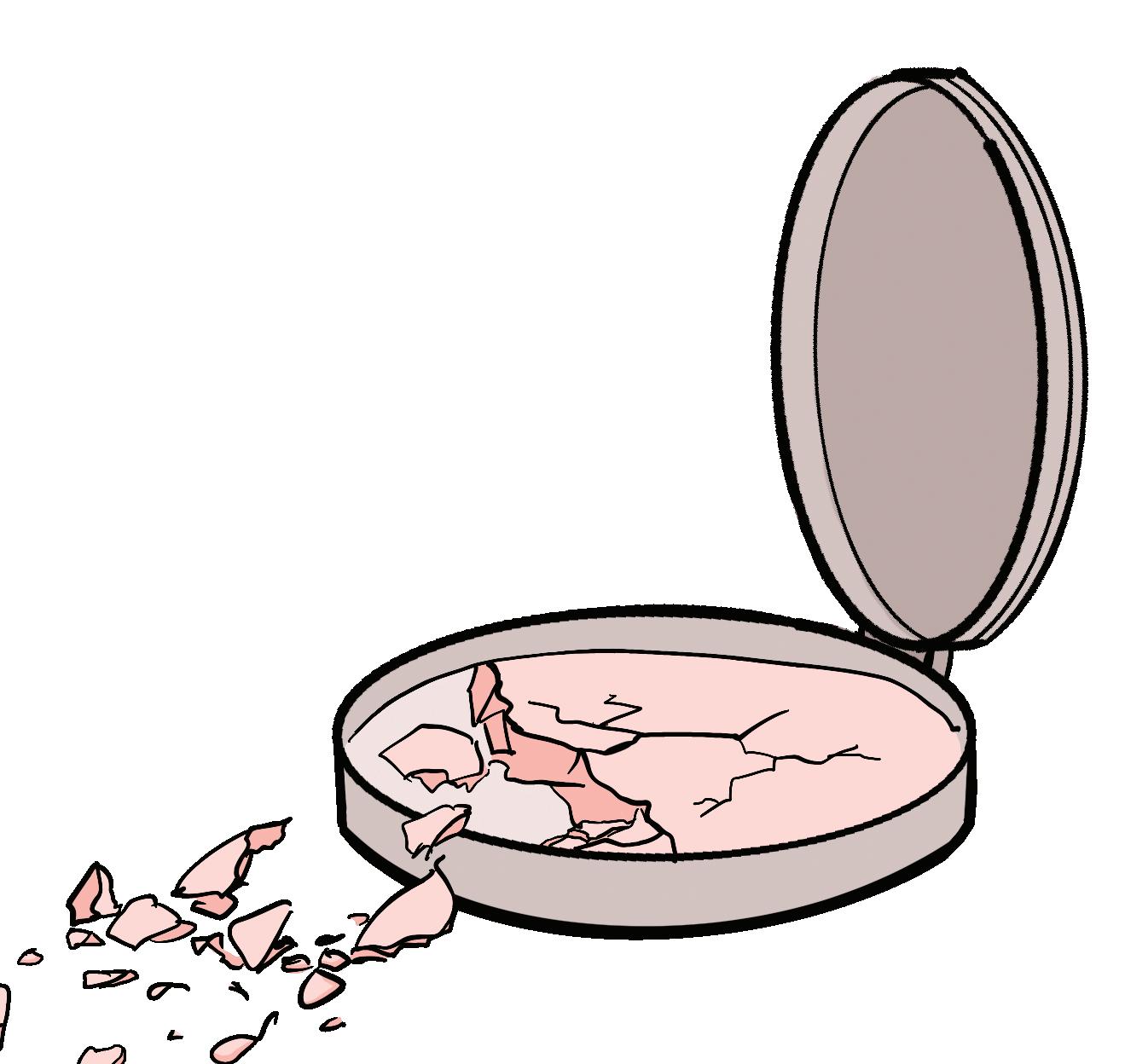
 Bryan Xiao Lifestyle Editor
Bryan Xiao Lifestyle Editor
When TikTok videos of preteens showcasing their product hauls from beauty store Sephora went viral in January, the tweens were met with widespread criticism. Sephora employees flocked to social media to share their experiences with young customers, recounting encounters with rude children and jumbled shelves of product.
This trend is a product of the recent growth in preteen social media presence, driven by peer pressure and a lack of parental control. Children who frequently use technology and social media prevent themselves from creating important real-life connections and developing social-emotional skills crucial for adulthood. At the same time, they risk addiction, mental health issues and exposure to harmful content.
with peers is essential. According to Mount Saint Mary College psychology professor Paul Schwartz, childhood friendships help develop social skills, including respecting others’ views and understanding conversational etiquette. Friendships also help children build a support system, decreasing their stress and increasing self-esteem.
Children who frequently use social media sites, however, are less likely to build friendships and more likely to have online-only peers, as a study led by research scientist Linda Charmaraman found in 2022. These digital relationships tend to be more superficial and less personal than in-person friendships, and therefore don’t serve as a proper support network. At the same time, preteens are more likely to engage in cyberbullying, and victims are at risk of psychological complications such as anxiety and isolation.
Access to social media has also created an environment that often promotes unrealistic standards. If children believe that their physiques fall short of the artificial image they compare themselves to, for example, they are likely to develop body dissatisfaction and eating disorders, according to a 2022 study headed by research scientist David Bickham. In a 2023 study from the
reduced their social media usage by 50% for a few weeks felt significantly better about their body and appearance.
Furthermore, younger children with unrestricted internet access may stumble upon sexual or violent content, leading them to become desensitized at an early age or to seek out such content of their own accord, as the American Academy of Pediatrics found. The Academy also found that adolescents lack the ability to regulate themselves online compared to adult users.
Parents of preteens can protect their children from the adverse effects of technology usage. To reduce the impact of addictive algorithms, parents should limit their children’s time on devices and prevent them from using certain social media sites, such as Instagram and Snapchat, until they are older. Social media companies must also realize the harm their products have inflicted and revise their policies to keep younger users from accessing their apps, with stricter age verification, better screening of mature content and increased parentalcontrol options. Ultimately, parents must work with their children to minimize the pitfalls of technology so they learn how to use it in a healthy manner.

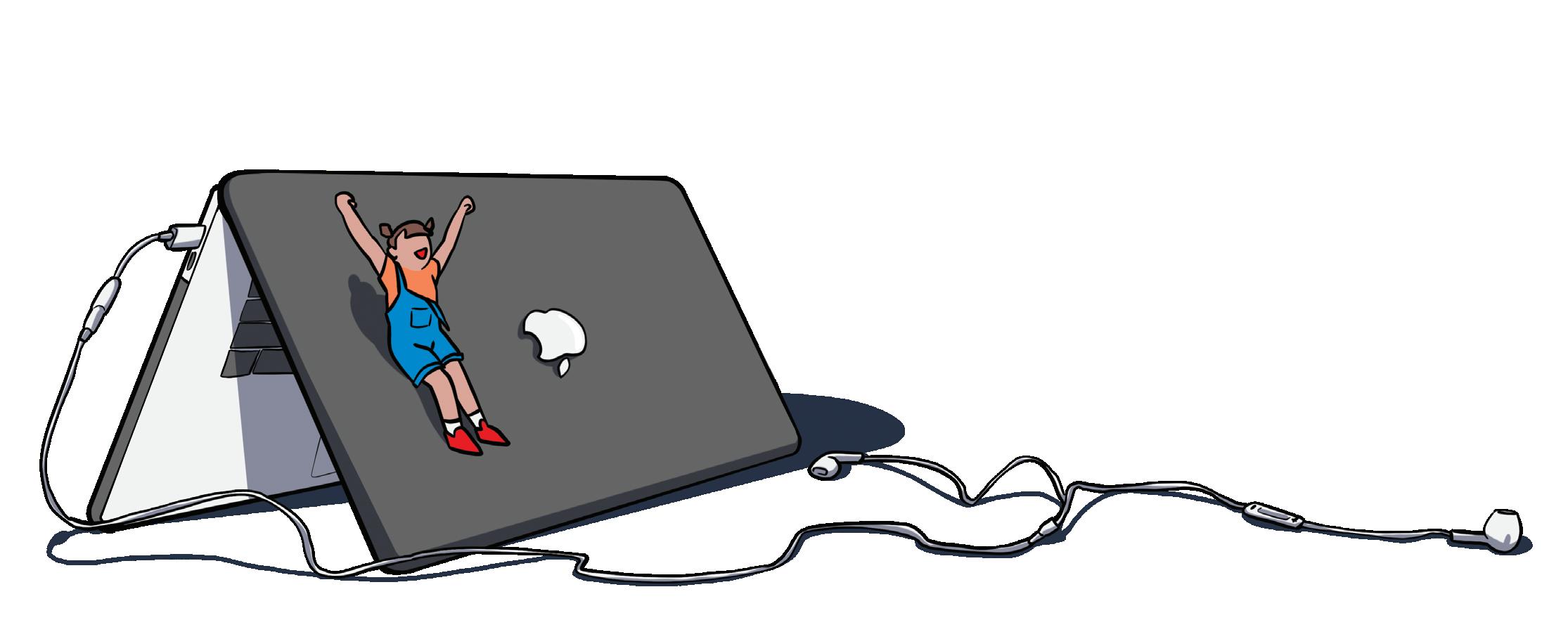


 Eanam Maor Reporter
Eanam Maor Reporter
A white professor avoids discussing the Black Lives Matter movement in fear of being deemed racist. A male student balks at participating in a social studies class discussion about the mistreatment of women in historical societies. Situations like these have become increasingly common in recent years: Teens and adults, intent on “political correctness,” shy away from controversial or uncomfortable discussions because they fear being shamed or offending others.
When people push for extreme political correctness, to the point where they censor and restrict ideas, they limit the potential for meaningful conversations, promote binary thinking and exacerbate polarization.
This oversensitivity is well intentioned. Those restricting their comments for political correctness — any measure taken to avoid offending or disadvantaging
feel safe and respected, it also drops when they fear challenging ideas. For instance, trigger warnings — originally intended to help vulnerable individuals prepare for and avoid traumatizing material — have since become common online, even in arguably unnecessary contexts, such as discussions about racial discrimination or instances of hateful language.
In fact, in an Atlantic article, author and attorney Jill Filipovic writes that trigger warnings often seem to be “more about emphasizing the upsetting nature of certain topics than about accommodating people who had experienced traumatic events.” The effect of trigger warnings has evolved into labeling controversial and uncomfortable topics as “dangerous.” This shift promotes ignoring distressing issues rather than learning to listen and work through them.
Additionally, political correctness makes differentiating between hate speech and controversial opinions difficult. By prioritizing limiting offense over understanding different viewpoints, oversensitivity can further create polarization and conflict.
Amid the Israel-Hamas war, for example, the conflation of hate speech and controversial speech has become especially visible: Criticism toward Israel is sometimes taken as antisemitism, and pro-Palestinian points of view are sometimes quickly classified as pro-Hamas. Such generalizations erase layers of important nuance in a complex geopolitical conflict, precluding understanding on both sides and exacerbating polarization. Thus, even if people disagree with certain opinions or find them to be hurtful, they must remain respectful toward one another
and listen with the intent of thinking critically about the issue at hand.
In higher education, political correctness has made college students — who will play key roles in shaping the future of the U.S. — afraid to engage in meaningful discourse. According to a September 2021 survey by Intelligent, an online magazine serving students, 52% of college students say they “always” or “often” hold back from expressing views on political and social issues in classrooms out of concern for being shamed or other potential consequences.
When people use their differences in belief as an invitation to better understand themselves and others, they improve trust and their relationships.
“ ”
College campuses are meant to be bastions of free speech, allowing students to engage with ideologically complex material with thoughtfulness and empathy. If students feel unable to voice opinions regarding controversial topics, they cannot learn. Moreover, these habits only become more entrenched later in life, discouraging students from advocating controversial or unpopular views beyond school as well.
Ultimately, oversensitivity to the point of extreme political correctness restricts discourse more than it protects people. Respect toward one another shouldn’t need to come at the expense of intellectual inquiry and necessary — if uncomfortable — conversations. When people use their differences in belief as an invitation to better understand themselves and others, they improve trust and their relationships. Nuanced discourse, built on dismantling extreme political correctness, renders a tremendous service to society. It is the first step
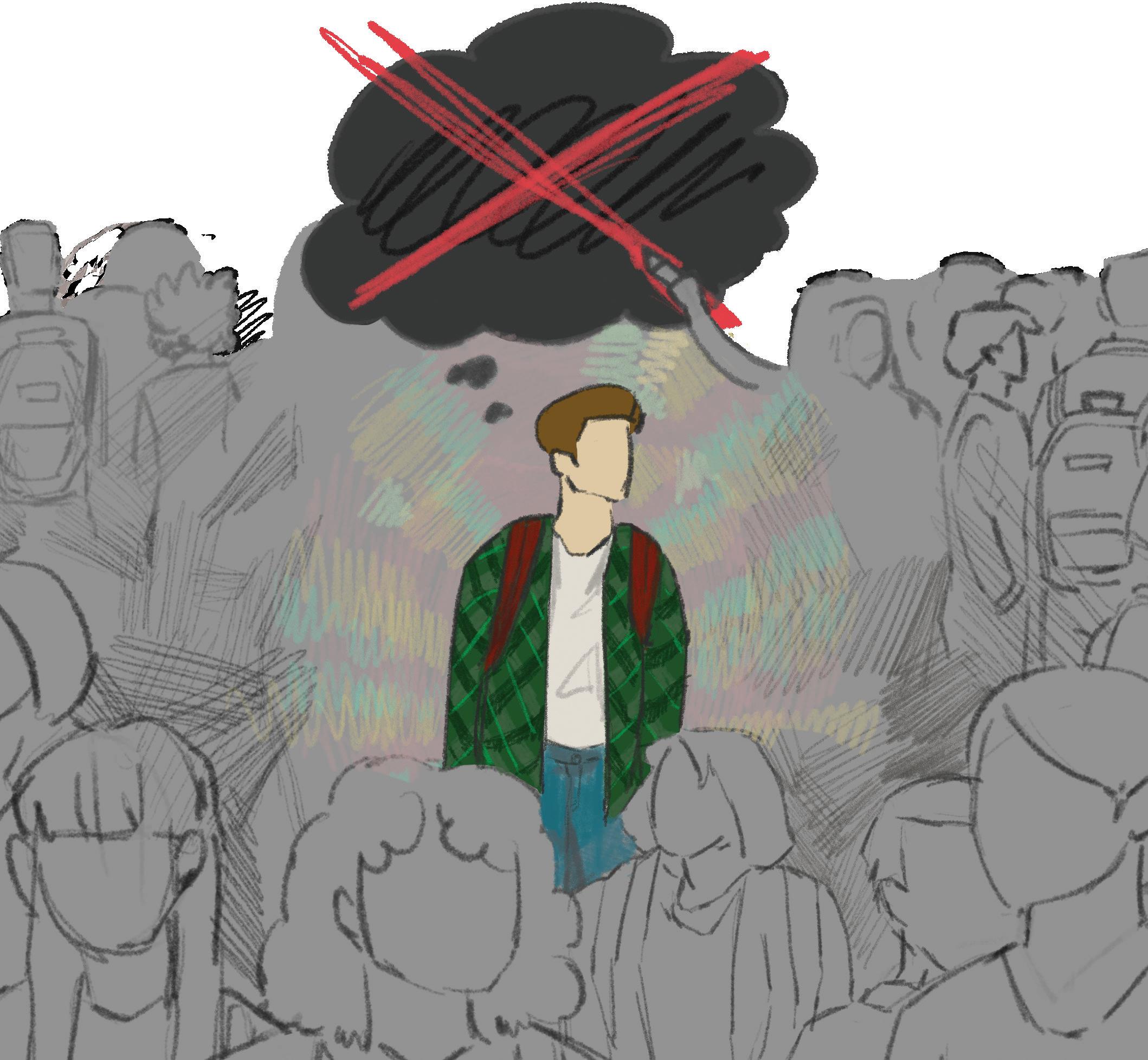
Sophomore Jaylen Wong joined the filmmaking world in middle school, when he signed up for the video production elective. However, it wasn’t until high school that he found his niche: sports filming.
Wong posted his first sports film on Instagram during his freshman year after attending a Gunn varsity football game. Although he received positive community feedback, he found that he struggled with adjusting to filming at night.
“During the game, I had to quickly search on YouTube how to fix the lighting problem, turn up the ISO (International Organization for Standardization) and turn up the aperture,” he said. “(I had to figure out) how to increase the lens so more light came through to brighten the shot.”
Wong’s personal journey as a basketball player played a large role in his decision to continue making films.
“I wanted to capture how it felt being there (on the court),” he said. “That’s why I wanted to film sports, because I think (it) is a really great way to show other people’s passions.”
Core lessons Wong had learned from playing sports contributed to his filming mindset.
“Many sports require a lot of patience and dedication, and that really transferred over to my filmmaking,” he said. “(I had to) dedicate a lot of time in post-production, filming (and) planning.”
Wong’s journey, however, wasn’t all smooth sailing. Most of his major filmmaking challenges occurred when he pushed himself out of his comfort zone and tried filming sports he wasn’t as familiar with. In a water polo video, for example, lighting posed a problem.
“It was light out, and it was hard to adjust my camera to the glare from the water,” he said. “Since it was my first time filming water polo, I needed to get used to the sport and
know what to look for.”
Usually, Wong creates multiple iterations of a video, and the full filmcreation process for a 90-second video typically takes around six hours from start to finish. Much of this time is dedicated to fine-tuning pacing.
“(Making a film) is like telling a story,” he said. “There’s a rising action, climax and falling action. I take that format and use it to (create) the video.”
Moving forward, Wong hopes to continue filming college sports to bolster his portfolio on Instagram. He has already filmed some Stanford basketball games this past season, and he and his twin brother, Liam Wong, are working to acquire media passes from the video director of Stanford’s football program, Mike Gleeson.
Despite the heavy workload, Wong finds the time commitment to be manageable, especially since he enjoys working on the videos. The feedback he receives further motivates him to continue to create films and seek new opportunities.
“Just seeing the athletes’ reactions make it worth it,” he said. “It makes me happy that they liked the video and that it wasn’t all for nothing.”
—Written by Anne Dong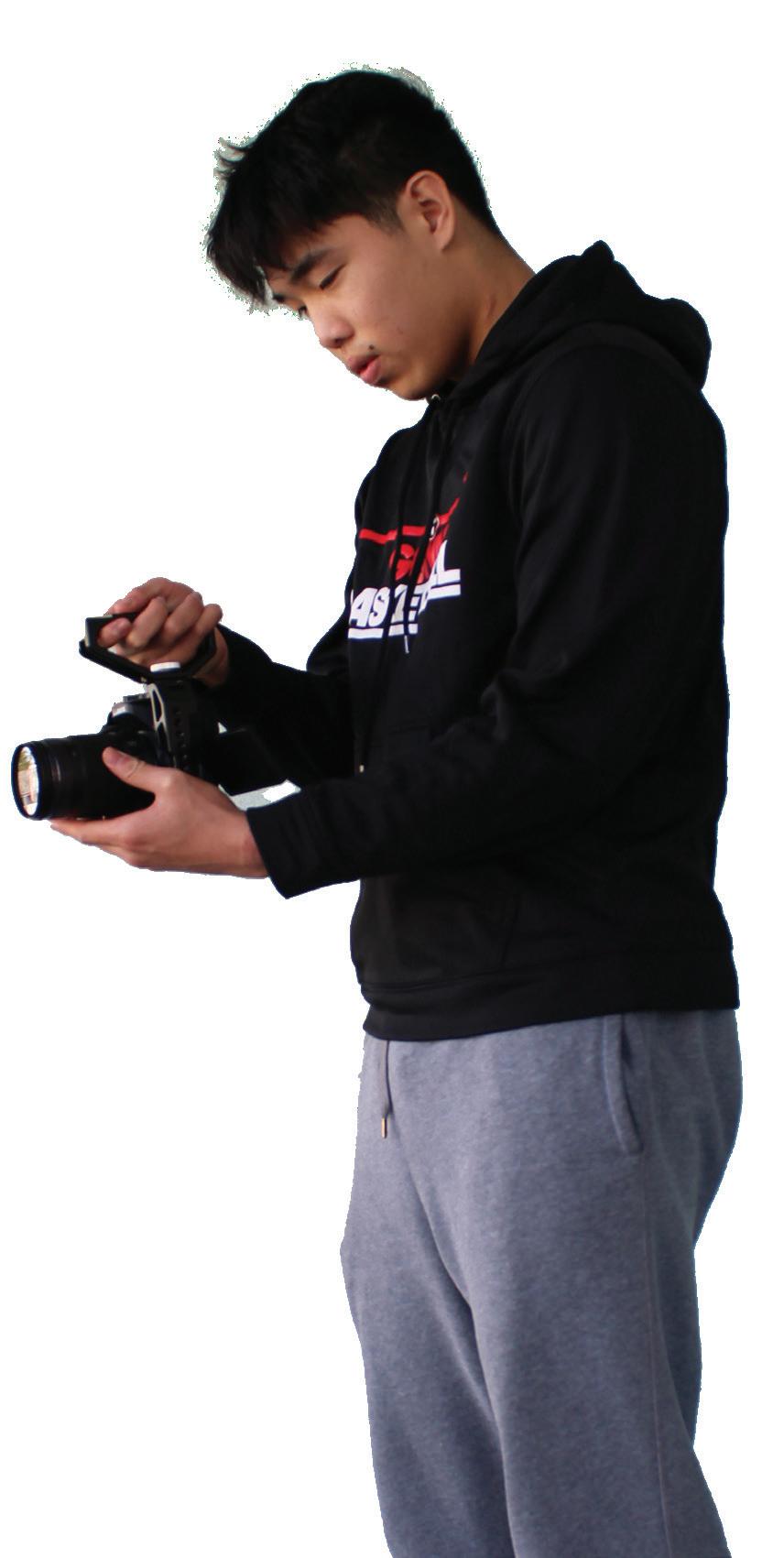





At 6 years old, senior Pablo Schettino González watched his first movie, “Happy Feet.” Transported to a world of talking penguins, he was entranced by the limitless possibilities of film. Since then, he has strived to create new worlds and evoke emotion in audiences through filmmaking.
From an early age, Schettino González enjoyed creating skits and helping his sister — now a film student at Chapman University — make movies. For him, pursuing filmmaking was a natural instinct.
“I was never as attracted to something as I was to film,” he said. “I don’t think there was ever a moment where I was like, ‘Okay, this is what I want to do.’ It was always just something that I had to do. I had to make these films. I had to see my passion through.”
Schettino González has explored a variety of filmmaking genres — sports documentaries, PSAs and narrative shorts, just to name a few — but recently homed in on storytelling through fictional short films. He has a meticulous process: brainstorming ideas, writing a shot list, creating a detailed script, filming with actors and editing. He focuses on finding ideas and stories that resonate with his own experiences.
Like all amateur filmmakers, Schettino González started out shooting with default camera settings. With experience and upgraded equipment over time, he acquired an eye for detail, learning to enhance every element to make his films come alive. One technique Schettino González has honed is sound design, which he believes adds another dimension to films.
“A lot of people … don’t realize how (sound design) can enhance the performance, how we can create depth to the story, how we can make the characters feel lived in and make the story feel lived in,” he said. “Just creating a world with sound is very important and something that I pay more attention to.”
Schettino González’s film “Querido Mexico,” which explores his gratitude towards Mexico while comparing it to the stressful environment of Palo Alto, won first place statewide at the Directing Change Film Contest and the regional award for the National Academy of Television Arts and Sciences Student Emmys. It was also nominated for a National Student Emmy. “Skateboarding with Lara Botto,” a film Schettino González created with senior Josh Scheinman, also received the regional award for the National Academy’s Student Emmys.
Schettino González has found it extremely rewarding to be able to network with actors and directors and spotlight important topics through films like “Querido Mexico,” which touches on student mental health and pressure.
In the future, Schettino González will continue improving his abilities and using film to bring meaningful issues to light.
“I see myself creating more impactful work, pieces that matter, pieces that touch on subjects that most people are scared to touch on, and collaborating with talented filmmakers to create things that stand out,” he said.
—Written by Vivien Chen
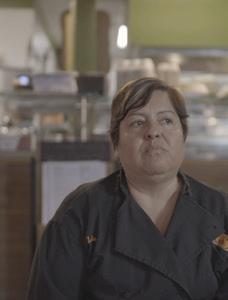
Senior Yahya Mirza stared down the track. He had not had any food or water in over 12 hours because he was fasting for Ramadan, and he was about to run a 400-meter race. Fatigue and weakness weighed him down as he took his place on a lane, anticipating the painstaking race before him.
Nevertheless, he made it through. After finishing the track meet, Mirza was physically drained, but his spirits were lifted.
“I realized that there are many other people who do (track) while fasting,” he said. “It gave me a new appreciation for the mental strength involved in the halal lifestyle.”
Mirza is one of many Muslims who partake in a halal lifestyle. This lifestyle is based on the concepts of “halal” (allowed or permissible) and “haram” (forbidden), which are taught in the Quran, the sacred scripture of Islam. The natural state of everything is halal, and things are haram only if specified in the Quran — pork, for example, is haram because pigs are considered unclean. These concepts apply to aspects of life beyond food, including social norms and individual beliefs.
“Universally, (the halal lifestyle) is no pork, no alcohol, no drugs,” Mirza said. “But there’s more to it with the halal lifestyle. I see the halal lifestyle as my moral code, along with the Islamic moral code.”
Freshman Hana Siddeek, who is also Muslim, noted that the distinctions between haram and halal aren’t always simple.
“There’s some circumstances nowadays where there’s not something specifically stated, so you have to use logic and reason and the sayings of the Prophet, peace be upon him, to infer the right decision,” she said. “There’s also varying degrees of disliked, allowed, permissible and encouraged.”
The strictness with which the lifestyle is followed also varies. Siddeek and her family are flexible with some things because of their personal beliefs and choices.
“Gelatine is sometimes taken from the insides of a pig, so a lot of Muslims won’t eat gelatine unless it’s halal gelatine,” she said. “But my parents (took) a class and their teacher told them that gelatine is chemically reformed — it’s a completely different thing and not actually pork. So, I eat gelatine.”
Nevertheless, finding food options can be difficult. Students may opt for vegetarian options simply because finding halal-certified food options can be challenging. While Mirza has faced these difficulties, he also noted that those at
477 California Ave, Palo Alto, CA

4131

Gunn do their best to make allowances.
“You can’t necessarily eat (school lunch) depending on which family you’re from,” Mirza said. “People (at Gunn) are supportive and they understand the restrictions that I have. I feel like Gunn makes the halal lifestyle relatively easy.”
Outside the realm of food, haram and halal also govern other aspects of daily life, including social interactions.
“I can hang out with my friends just fine, but if my friends are making bets or playing poker, I just don’t put any money in,” Mirza said. “(Living halal) also teaches me how to create my own boundaries so people don’t cross them.”
For Siddeek, part of living halal is not dating.
“I don’t date,” she said. “This is a reason why I prefer juvenile fiction, because a lot of the young-adult fiction features people doing stuff that they wouldn’t normally do unless they were married, but they’re not married. That makes me a little uncomfortable.”
Ramadan is still another crucial aspect of living halal. During this sacred ninth month of the Islamic calendar, Muslims fast, waking up before sunrise for a meal and praying afterward. While fasting, Muslims do not eat or drink, including water. Prayers are segmented throughout the day: dawn (“Fajr”), early afternoon (“Dhuhr”), later afternoon (“Asr”), sunset (“Maghrib”) and evening (“Isha”).
These daily prayers allow Mirza time for introspection. While he tries to pray five times a day, most days outside of Ramadan, he prays once in the early morning and once before bed.
“Living halal affects me in a positive manner because every (day) through prayer, I get to reflect upon my own feelings and show gratitude towards my own life,” he said.
While many of Siddeek’s experiences with Islam have been shaped by her parents, she has gradually learned to embrace and interpret the religion in her own way.
“As I learn about (Islam), I’ve started to (follow) it more of my own accord because I understand it,” she said. “Just learning by myself and learning from my parents’ guidance has helped me to live this way.”
—Written by Claire JittipunSophomore Yoni Dadon and his friends often go to McDonalds to get a bite to eat. Each time, they order a feast of nuggets, chicken sandwiches, hamburgers and a myriad of other items on the menu. Whenever Dadon tags along, the menu of 145 items is narrowed down to his one — his only — kosher food option: fries.
In the realm of dietary customs, few are as distinct and meticulously specific as the kosher lifestyle. The English word “kosher” emerges from the Hebrew root “kashér,” symbolizing purity, propriety and suitability for consumption. This concept, deeply rooted in Jewish tradition, is governed by a set of laws known as “kashrut,” outlined in the Torah, the central reference of Jewish sacred texts. The application of these laws extends beyond simple dietary restrictions and encompasses a comprehensive lifestyle that influences not only what one can eat but also how food is prepared, processed and served.
Kashrut divides food into three categories: “fleishig” (meat), “milchig” (dairy) and “pareve” (neither meat nor dairy), each subject to strict guidelines. For instance, meat must come from certain animals that chew their cud and have split hooves, and these animals must be slaughtered in a specific manner to be considered kosher. Dairy products, on the other hand, must come from kosher animals and cannot be mixed with meat. Pareve foods, including fish (only with fins and scales), eggs and plant-based items, serve as a neutral category, compatible with either meat or dairy.
These laws not only dictate the types of foods that are permitted, but also mandate the separation of meat and dairy products to an extent that even the utensils and kitchenware used for their preparation must not make contact. The period between consuming meat and dairy varies among communities, typically ranging from one to six hours, reflecting the diversity in observance levels.

While some Jewish families follow these laws strictly, others do not. Junior Ronnie Horowitz, who grew up in a secular Jewish family in Israel, doesn’t restrict what she eats based on kosher guidelines. This approach to Judaism means that cultural identity may not necessarily include strict adherence to dietary laws.
“It never made me feel more or less Jewish,” she said. “I practice in my own way and those practices don’t include keeping kosher.”
365 California Ave. Palo Alto, CA
Contemporary eatery specializing in Indian and Pakistani dishes

118 E. El Camino Real, Sunnyvale, CA
Fast casual restaurant chain offering Nashville-inspired fried chicken


In contrast, sophomore Yoni Dadon and his family have always maintained a certain degree of kashrut. His family follows the traditional waiting period between consuming meat and dairy, separates utensils and plates for dairy and meat, and factors kosher laws into restaurant choices.
“It means a lot to me because when I eat kosher, I feel more connected to my Jewish identity,” he said. “I’m upholding Jewish tradition and doing what my family did before me.”
Navigating the practice of keeping kosher often intersects with social dynamics, leading to moments of hesitation and stigma. According to Dadon, keeping kosher can occasionally impact interactions with friends, particularly when going out to eat.
“Sometimes, it can be embarrassing when I have to eat something kosher or order something special in front of others, but I try not to let it affect me,” he said.
Keeping kosher proves a challenge outside of home, because there are limited kosher restaurants and options in Palo Alto. Dadon’s family often eats at pizza places such as Domino’s when going out, or at restaurants like True Foods, which has a plethora of vegan and vegetarian options.
Horowitz also noted that some students hesitate to share their dietary choices, and choose to instead say they are allergic or vegan.
“Keeping kosher is something friends are embarrassed to admit,” she said. “For example, my friend wouldn’t say he won’t eat pork because it isn’t kosher — he simply says he doesn’t eat pork. It seems too complex to explain.”
Exploring the varied paths of keeping kosher reveals a profound sense of identity and tradition for many, including Dadon.
“As I get more freedom as I grow older, I think I will keep kosher because it means something to me,” he said. “It’s more than just a diet.”
Horowitz’s perspective values personal choice and the diversity of Jewish practice.
“I don’t intend to change my lifestyle to fit someone else’s definition of what being Jewish is,” she said. “You should never tell someone how to practice their Judaism.”
—Written by Annabel Honigstein
reFusing to be ruled: Performers grow beyond restrictive body, beauty standards
Long legs. Long arms. Being on the lean side, while still maintaining a good amount of strength.
For freshman Sara Su, who does contemporary and Chinese traditional dance at the Academy of Palo Alto Performing Arts, this physique always seemed ideal for a dancer. Her studio does not enforce these body standards as harshly as other studios, but Su has met dancers who have struggled to fit themselves into this image. Her dance teacher, for instance, attended a special dance school in China that required their students to remain very lean.
“They had to weigh themselves to make sure they were within a range that was acceptable,” she said. “If they wanted to go to a specialty dance college, they had to take different body measurements, and that was a big part of whether you could get in or not. I’ve heard about these standards all the time — people really struggling to fit into these standards and people who are malnourished because of it.”
Surrounded by younger dancers at her studio, Su has also felt these standards harm her self-esteem.
“I dance with a lot of younger girls, who haven’t really hit puberty yet and are really lean,” she said. “There was a period of time when standing next to them, there was a really big comparison. It was like everyone else on the team was super lean, and then there was me. It’s kind of hard to look at yourself like that, even though I was at a healthy weight for my age.”
Su believes these standards exist because of the emphasis on visual elements in dance: Audience members observe the dancers’ “lines,” critiquing the lightness or grace of their movements. There are trade-offs to creating a slimmer image to conform to these standards, which can damage dancers’ health.
“When you try to become skinnier, you eat less, and when you eat less, you don’t have enough energy — it’s kind of like a domino effect,” Su said. “It’s affected me because, while looking more aesthetically pleasing, I don’t have enough energy for different techniques that I
have to do on stage. And I don’t think that’s a worthy sacrifice.”
As she has furthered her dance training through the years, Su has come to realize that physique is not the sole distinguisher of a great dancer.
“I had to learn that looking visually pleasing doesn’t just mean that you have to be skinny,” she said. “It’s also about how you’re able to interpret the music, express your emotions and do your technique. All those things contribute to being visually pleasing — it’s not just about your body type.”

 —Written by Kaitlyn Chen
—Written by Kaitlyn Chen

When former Gunn student sophomore Jaslyn Kwan walks into a dance studio, she can’t miss the abundant mirrors: They reflect her and other dancers’ silhouettes, helping them pinpoint misalignment and selfcorrect. However, they also produce distorted images, sometimes creating or exacerbating body-image issues.
Kwan started dancing at the age of 3 and has been doing ballet, ballroom and contemporary dance competitively for the past decade. Over the years, she has sometimes found it hard to avoid noticing her physical appearance as she dances.
“It’s sometimes hard to look at the mirror because there are mirrors that make you look way different than you (actually) do,” she said. “Instead, I think that it’s important to use those mirrors as a tool to help you correct yourself, rather than to stare at your body and try to think about how you could fix the way your body looks. It’s hard to keep that mindset, but it’s really important.”
Ballet dancers are encouraged to be mindful of their diet to uphold the traditions of the art and maintain peak condition. Kwan has met challenges maintaining this balance.
“As a kid, I would eat whatever I wanted and I would look the same everyday,” she said. “But as I got older, I noticed that it wasn’t like that anymore.”
Kwan recognizes that this trend has historical roots. In fact, her Russian-trained instructors’ experiences have impacted their approach to nutrition.
“When (my teachers) were in Russia, they were taught that you need to be skinnier,” she said. “But I think that (since they’ve) been in America for so long, they learned that it’s not respectable to say that.”
Despite the common misconception that a ballerina needs to be thin,




Kwan notes that the industry, like her instructors, may be adapting its strict aesthetic standards to increase body inclusivity.
“It’s nice for ballerinas to have perfect hyperextending legs and beautiful arches,” she said. “But now, in this generation, I think it’s very clear that you can still have that gorgeous ballerina doing the same exact things without it.”
Effective nutrition has improved Kwan’s overall wellness and performance, including her stamina. Still, Kwan struggles with selfimage occasionally, especially in an industry where the aesthetic details of physique are prioritized.
“I’m still in that journey of trying to make myself understand that (unconventional physiques are) okay, as long as I’m staying healthy,” she said. “I try to tell myself that even though I look in the mirror and I see this (or) that could be fixed, I try to look at the good things (such as) having a good soft port de bras (arm movements), and that’s really helped me get through it.”

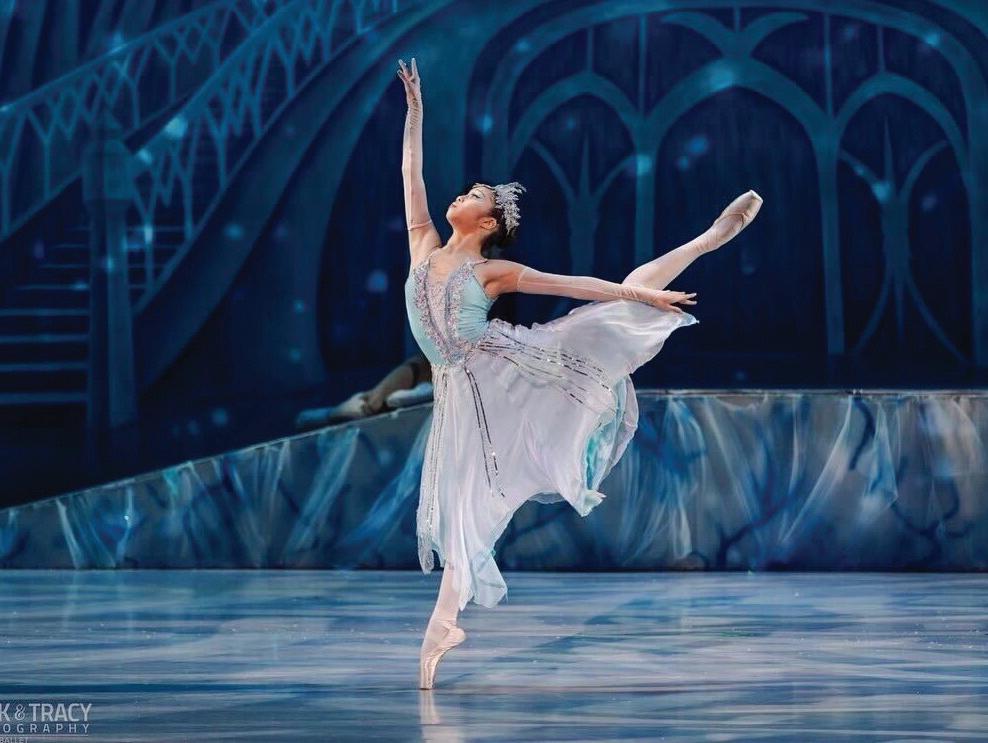 —Written by Charlotte Qian
—Written by Charlotte Qian

Senior Oviya Rajan has been dancing Bharatanatyam with the Abhinaya Dance Company of San Jose for 12 years now. A classical Indian dance, Bharatanatyam originated in the state of Tamil Nadu in southern India, and has become a way for Rajan to express herself.
While her initial push to dance came from her mom, Rajan has appreciated the opportunity to connect with her Indian heritage and understand Indian mythology. With her passion, however, has come the toll of a distorted body image, perpetuated by deeply rooted body and beauty standards in the Bharatanatyam dance community.
“Body-wise, I do think a lot of the dancers that are seen on stage are skinnier, and your teachers are constantly trying to make sure you’re staying fit,” Rajan said. “There’s also a stigma around height — if you’re taller, it’s harder to look ‘cleaner,’ and so they put a lot more pressure on you to not appear as lanky.”
Rajan recalled practicing a dance position called “Aramandi” that — like a plié — calls for dancers to bend low to the ground. Her taller teammates were forced to sit even lower to appear smaller.
“It’ll look like you’re not even in the position if you’re a taller dancer, whereas as a shorter person, it’s a lot easier to get away with it,” Rajan said.
Bharatanatyam costumes occasionally show the midriff, and Rajan has noticed how tops are tied to create a cinching effect, mimicking a corset. Bharatanatyam costuming has further perpetuated unhealthy body standards in an attempt to create the illusion of a larger bust: Rajan remembers performances for which makeup artists would advise her to pad underneath her blouse and drape.
“My mom thankfully vetoed that one,” she said. “There is always this pressure to not gain as much weight, so you look better. In the costume, you’re wearing four layers of clothing, so in the past when I’ve gained a little bit of weight, I’ve always looked in the mirror and thought to myself, ‘Now this piece fits weirdly here.’”
When Rajan works with makeup artists, she has noticed how they emphasize appearing paler on stage, using terms like “nicer,” “creamier”
and “whiter.” When living in India from 2016-17, she noticed that this colorist ideal was intensified.
“In India especially, there’s always been a divide between darker and lighter skin, and when you’re more fair, people think it’s prettier to look at,” Rajan said.
As Rajan has continued her dance training, she has come to value her community as a support system.
“During harder performances, we all rely on each other and we all depend on each other for emotional support,” she said. “I’ve had rehearsals go to 12 a.m. or go for four or five hours. We’ve had to perform in really awful temperatures and heat, but we have each other’s backs, so it’s just a really good community.”



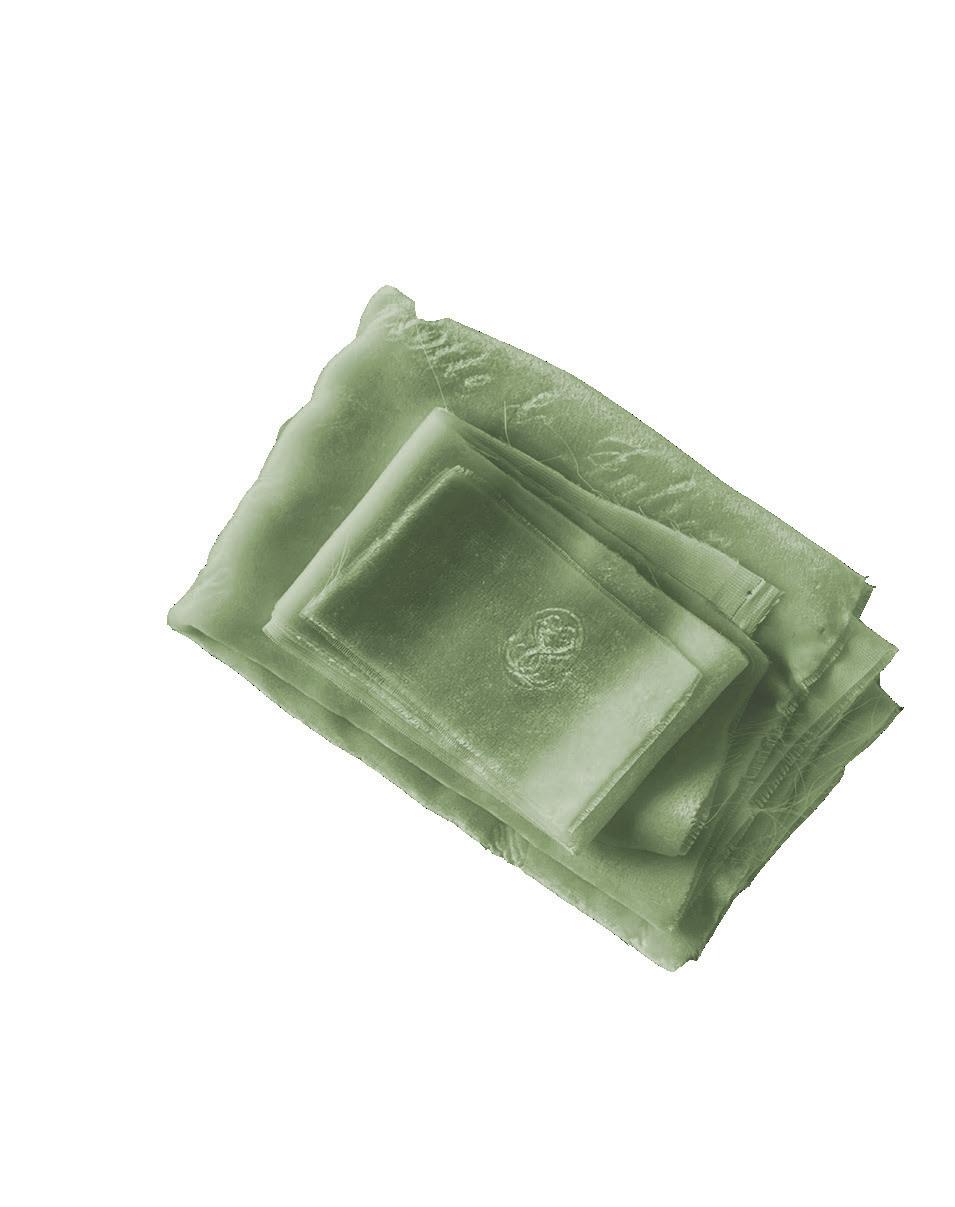
Hands smothered in chalk and exhaling a deep breath, Class of 2023 Gunn alumnus Aaron Novick stepped onto the competition floor, ready to showcase his skills to a roaring crowd. He jumped and gripped the pommel horse, legs straight and arms twisting rapidly, spinning and spinning — until he fell. Brushing it off, he continued to the rings, executing every step of the routine until he faltered again.
The weight of disappointment settled in — Novick had practiced for weeks on this routine and he had let his nerves disrupt his mentality.
“I remember feeling like a failure, and I started tearing up in my corral — like that just broke me,” Novick said.
With the support of teammates and coaches, though, Novick finished his events victoriously.
Inspired by the 2008 and 2012 men’s Olympic gymnastics teams, Novick has been training since he was 3, starting with Little Gym and gymnastic clubs in San Jose before moving to the Stanford Boys Club and now the GymACT Minnesota men’s gymnastics team.
With supportive teammates and coaches, many of the struggles Novick faced during his gymnastics journey came from his own anxieties. Looking in the mirror, Novick would often compare himself to his teammates.
“For me, the standard for male gymnastics is to be fit and to show that you have muscle definition and that you are strong — that kind of implies that you are a good athlete,” Novick said. “Back when I was younger, I did not fit that mold and that’s what I would work towards.”






Because of this pressure, Novick would often “cheat” — or cut his assigned exercise shorter — because did not believe he was as strong as teammates who were more toned than he was.
“I felt I was physically weak compared to all my teammates because they kept finishing strength before me,” Novick said. “That was something that affected me negatively mentally, because I felt like, ‘Oh, I’m not strong enough. Oh, I suck at strength. I’m not going to be as good enough as my teammates.’”
As he became stronger with training and began accepting his own physique, Novick shifted his focus from his body to his skills.
“I would get stronger, and that’s when I started to view my body in a more positive light because I did all this hard work to get where I am today,” Novick said. “I felt better about myself.”

Strength, flexibility and skill competitions in the gym helped him accept the physical differences among him and his teammates.




When English teacher Terence Kitada was younger, he witnessed his sister, an avid video game enthusiast, struggle to find acceptance in gaming communities dominated by her male peers.
“(When my sister went) off to college and she was like, ‘Want to play Mario Kart?’ all the boys were surprised,” he said. “They were like, ‘What, you know how to play this? But you’re a girl!’”
This sentiment still persists. Marginalized individuals who play video games in the modern day face toxicity and harassment from other gamers much more frequently than their non-marginalized peers. A 2021 study by the Geena Davis Institute on Gender in Media, an organization that works to reduce negative stereotyping in entertainment and media, found that 50% of gamers between the ages of 16 and 19 witnessed homophobic language while playing video games. Of the same age group, 47% witnessed racist language, 41% reported seeing sexist language and 41% reported ableist language.
Female gamers today are often forced to guard themselves from sexist and sexual comments from men. According to the 2021 Geena Davis Institute study, men “were found to feel more entitled to express social dominance in the virtual world than in the real world, because men outnumber women in networked video games and masculine behavior is typically rewarded.”
said. “There’s a lot of ignorance surrounding neurodiversity, and they definitely weaponize that.”
According to Kitada, video games’ allowance of anonymity facilitates online misbehavior and harassment.
“If you can’t see the reaction of the person you’re hurting, then it’s the sense of, ‘Oh, I can say whatever I want and just be as mean as I want,’” he said.
Despite the rampant negativity from other gamers, marginalized groups can find safe havens by forming sub-communities with gaming as a mutual interest. Gonzalez was a part of one such group.
“I found a really unique community at my undergrad: other people just like me, other girls also interested in gaming,” she said. “I could talk about Call of Duty: Black Ops, and before, that would never happen.”

Special Education Instructional Lead and English teacher Briana Gonzalez has been harassed on the basis of her gender by fellow gamers.
“Far Cry: New Dawn had a co-op option that I really enjoyed, and unfortunately I just don’t participate in it anymore, just because the moment they hear my voice, it’s just really inappropriate,” Gonzalez said. “I unfortunately have experienced sexual harassment through online gaming.”
Senior Emma Cao, who is experienced with online gaming, has also found the world of gaming to be dangerous. She takes measures to minimize her chances of being harassed when interacting with other gamers online, though they are not foolproof.
“I protect myself a lot — like I don’t talk when I don’t need to,” she said. “I speak in a lower intonation. It sucks that (harassment) happens. You just have to pray that the loser named CatWoman420 doesn’t choose to hate you.”
Ableist language is also abundant in gaming communities. Senior Vincent Boling, who is autistic, has experienced hostility from other gamers because of his neurodivergence.
“(If) I was trying to communicate with my teammates, and I was maybe a little sloppy, or I was not always picking up on the implications of the signals, then I would definitely get pretty ragged on for that and called a lot of slurs and stuff,” Boling
Increasing the diversity of video game characters may also help marginalized gamers feel welcome in online spaces. In many games, character customization options are limited and don’t allow marginalized players to accurately represent themselves in the game.
“Especially if your characters are supposed to serve as your avatar, you’re supposed to create somebody who looks like you, right?” Kitada said. “What are the character creation options, or is it just standard like a bald, young white man? So many FPS (first-person shooter) games have that kind of character who’s the standard avatar. You’re like, ‘That’s not me.’”
One way to improve representation in video games is to introduce more diverse viewpoints into the game development process. The field is currently heavily male and white dominated, with 62% of developers identifying as male and 78% identifying as white, according to the International Game Developers Association 2021 Developer Satisfaction Survey.
“I just feel like companies need to be a part of this (diversification) process and re-evaluate their own culture and their own hiring practices,” Gonzalez said. “Because as long as you’re only hiring a certain group of people, that’s the content you’re gonna get in turn.”
According to Boling, harmful comments online often come from miseducation rather than malice. As such, these instances of bullying can be sometimes leveraged as opportunities for growth.
“A medium like a video game where you’re cooperating is a good time for people to learn and grow,” Boling said. “A lot of gamers are stubborn and old and terrible, but most of them aren’t. Most of them are just kind of cranky, but are genuinely willing to listen.”
—Written by Victor Dang
Senior timon CappellaPimor’s guide to pc
Step 1:
Insert the central processing unit into the motherboard, or the main circuit board that holds the important PC components. Typically, the socket for the CPU will be near the center of the motherboard. Bring the ring surrounding the slot up, place the CPU directly into the middle of the socket and lock it back in by lowering the bracket.

Step 3:
Install the graphics processing unit. Unlock the GPU slot by pressing down on its latch — a plastic, small piece at the very end of the slot. Slide in the GPU, locking it in by pressing the latch closed.

Step 5:

Insert random sticks into Slide each corresponding that the notches correctly sticks and place with

Install the the PC case. should have bottom for screws, or the PC case the screws and the touching.

Install cooler into the case. There are multiple types of PC coolers, such as fans or liquid coolers, that manage the temperature of the motherboard’s components. Install the Plug the power into an outlet. case, find plug the power corresponding motherboard.

Step 7:
Press the power button. With everything installed, the computer should start properly. Once the computer is on, install your operating system — perhaps with a USB drive — and connect to the internet. Happy gaming!



Cappellapc building

Step 2:
random access memory into the motherboard. each RAM stick into its corresponding slot, ensuring notches are lined up by centering the and locking them into a click.

Step 4:
the motherboard in case. The motherboard have four holes on its for screws. Align the or “standoffs,” inside case here, such that screws keep the PC case motherboard from

Step 6: power supply unit. power supply’s cords outlet. Opening the PC the connectors and power leads into their corresponding slots on the motherboard.


“Do you have the game Roblox?”
For freshman Cassandra Mission, this simple question — posed by a friend in third grade — opened a whole new world. After installing the game, she was entranced. Mission continues to enjoy gaming on Roblox, an online platform offering a variety of user-created games, because of its multiplayer features. Two games that Mission has completed with her friends are The Mimic and Apeirophobia. The Mimic is a survival horror game that has two main stories, while Apeirophobia involves solving puzzles while
On a particularly dreary day during quarantine, sophomore Yuyou Zhang’s brother introduced her to what is now her favorite game, Valorant — a teambased tactical first-person-shooter game.
Exploring new gameplay strategies allowed Zhang a reprieve from everyday life, and she enjoyed looking out for new skins or updates.
“There’s a lot of techniques in the game,” Zhang said. “Sometimes I watch streamers or pro-players and try to improve myself.”
Nowadays, Zhang finds herself gaming less, but Valorant remains her favorite game: She enjoys its competitive nature and being able to play with friends.
facing dangers.
“Overall, it’s a fun experience because there’s also times where you can just goof around with friends,” Mission said. “(And Apeirophobia) is a fun experience because we thought the game was very well made and the details are good.”
However, Mission balances her gaming life and school life with a system that works well for her.
“I usually tell myself, once I get home, that if I get my work done, I could have the rest of my time to play games for as long as I’d like,” she said. “It’s actually very useful.”
—Writtenby
Michelle Koo“It’s more fun that way,” Zhang said. “I would definitely recommend (joining) with people who don’t get angry easily based on how you or your teammates are playing.”
Familiar with the darker side of gaming, Zhang encourages aspiring gamers to be aware of their limits.
“When you keep losing games, it gets kind of frustrating,” she said. “Don’t take the game too competitively or too seriously because it will ruin your relationship with (it).”
—Written by Vanisha Vig
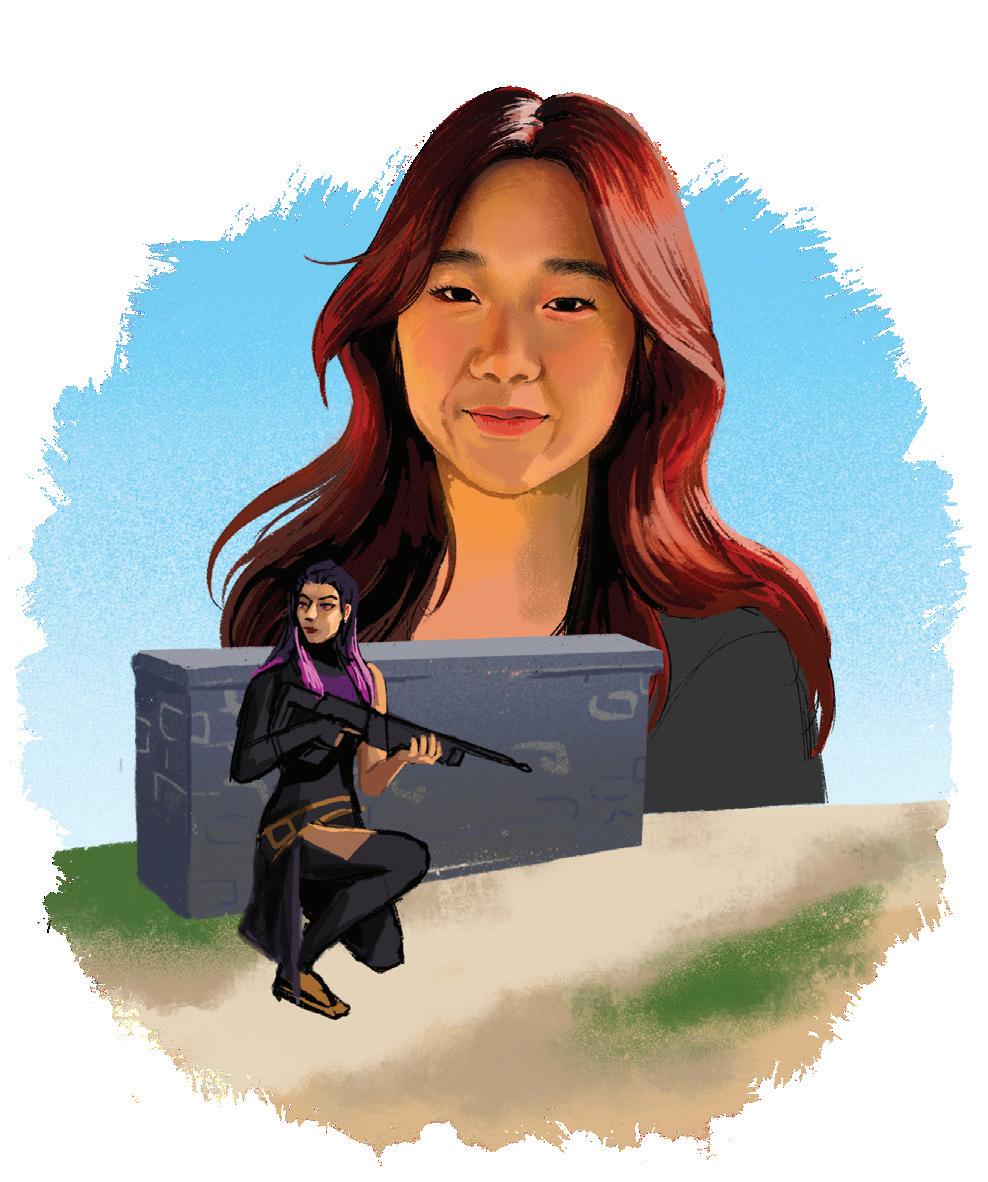
As the finish line looms, junior Max Zeller’s fingers dance across the keyboard. His body coursing with adrenaline, he pivots his character to the portal. Zeller finishes the run and lets out a sigh of relief: He’s beaten his record completion time for Minecraft.
Zeller began playing Minecraft in elementary school. Every time an update came out, he had a tradition of beating a new “hardcore” world — one that did not allow respawning.
In middle school, Zeller discovered speedrunning — the act of trying to finish a game in the
Senior Ethan Zhou remembers playing his first game, Purple Place, when he was a few years old. While he did not fully understand how to play, he was still hooked: The colors and audio of Purple Place — which included a tile-matching memory game and a cake-line management game — enticed him.
“I thought the cake game was hard,” Zhou said. “(But) it was a great and constant stream of tasks with no room for vacation.”
Today, Zhou enjoys various games, especially Valorant and The Witness, a single-player game with over 500 puzzles.
Zhou appreciates Valorant’s capacity to explore the various characters.
shortest amount of time — by repeatedly playing Subnautica and Stardew Valley. Although he finds speedrunning fun, he believes there is still value in playing through games normally.
“Before speedruns, I always go though the game once (to) experience the game and feel the adventure,” he said.
While Zeller still enjoys speedrunning, he has now been drawn toward more strategic games, such as Starcraft. He believes these games sharpen his skills.
“Some aspects can help improve my reflex skills and strategy,” he said.
—Written by Jeffrey
Kang“(In Valorant,) I can be the cool assassin I’ve always wanted to be,” he said. “I love to play Neon, (and) my friends call me Dr. Thunderfinger.”
The Witness, also colorful, involves mazes and methodical combinations of rules and symbols.
“It is (mostly) about perspective and philosophy,” he said. “This is the greatest recommendation to people who enjoy intelligence — it is the quintessential puzzle game.”
—Written by Michelle Koo


On Jan. 30, PAUSD Assistant Superintendent of Secondary Education Dr. Guillermo Lopez moderated the second ethnic studies community meeting alongside Gunn and Paly teachers on the district’s Ethnic Studies Committee.
Although the virtual meeting was advertised as a “community input session,” per Superintendent Dr. Don Austin’s Jan. 26 Superintendent’s Update, many questions in the Zoom chat — where participants were directed to ask their questions — remained unanswered.
Instead, toward the end of the meeting, which ended 15 minutes earlier than scheduled, community members could fill out a form with any remaining questions. When a similar form was sent out last December, however, parent of PAUSD alumni Lori Meyers emphasized the difficulty of giving specific feedback, as the substance of the course’s units and lesson plans wasn’t included.
“The community in general, and myself included, found it really difficult to understand exactly what we were giving feedback on, because it was something like, ‘What is your feedback on the section titled “Identity?”’” Meyers said. “We were like, ‘We don’t have any information’ — (the form) didn’t give us any real content to delve into.”
In a follow-up conversation with Lopez said that responses to questions asked on the form would be posted to the district’s ethnic studies webpage in the near future, but wasn’t able to provide a firm date.
The Jan. 30 meeting was one of many instances in which community members raised questions about PAUSD’s new ethnic studies class. Passed in October 2021, California’s A.B. 101 mandates an ethnic studies-course graduation requirement for all public and charter high schools. The requirement aims to acknowledge the state’s diverse population in its curriculum, and follows research co-authored by Stanford Graduate School of Education professor Thomas Dee in 2021 demonstrating ethnic studies’ positive impact on attendance and graduation rates for ninth-grade students.



In PAUSD, freshmen will first take a semesterlong ethnic studies course — which aims to “examine California as a microcosm of the United States and focus on themes of social justice, social responsibility, and social change by increasing student agency” — before covering world history in the second semesters of ninth and 10th grade.
While ethnic studies has long been a contentious matter, tensions have risen since the onset of the Israel-Hamas war on Oct. 7, with educators, parents and students attempting to reconcile their ideas for the content and structure and content of the course.
On Nov. 6, 1968, the Black Student Union and Third World Liberation Front, a coalition of ethnic student organizations, went on strike at San Francisco State University (then San Francisco State College) to advocate for more diversity in the admissions process and for the creation of a school of ethnic studies. After more than four months of striking, San Francisco State established the nation’s first College of Ethnic Studies, which began operating in fall 1969.
Though it remains one of the only institutions of its kind in the U.S., ethnic studies courses have since become more common at other colleges and universities.
Five years prior to A.B. 101, former California Gov. Jerry Brown signed A.B. 2016 into law on Sept. 13, 2016, mandating the Instructional Quality Commission to develop an ethnic studies model curriculum for high schools. When the commission completed their first draft, however, it faced backlash for being ideologically
antisemitism. On Aug. 12, 2019, California Board of Education President Linda Darling-Hammond announced that the Instructional Quality Commission would be submitting a new draft to the Board for approval.
“Ethnic studies can be an important tool to improve school climate and increase our understanding of one another,” she wrote in a press release. “A model curriculum should be accurate, free of bias, appropriate for all learners in our diverse state, and align with Governor Newsom’s vision of a California for all. The current draft model curriculum falls short and needs to be substantially redesigned.”
After three additional drafts, on March 18, 2021, the California Board of Education adopted a 688-page model curriculum. Although the course’s primary focus remained on African Americans, Asian Americans, Latino Americans and Native Americans — the groups most college ethnic studies courses center around — the model curriculum expanded to include lessons on other ethnic groups in the U.S. Furthermore, the final draft included guidance to teachers on establishing trust when discussing complex topics and presenting balanced coverage of issues.
Some on the commission, however, were dissatisfied with the final model curriculum. A September 2023 letter from the University of California Ethnic Studies Faculty Council expressed concerns over the weaponization of “guardrails,” which preclude ethnic studies from promoting any discrimination, bias or bigotry.
The first draft of the state model curriculum included lesson outlines on the Boycott, Divestment and Sanctions movement against Israel and studies
have criticized for anti-Israel comments.
The final version does not include these lessons, instead focusing on the history and contributions of Arab American communities, as well as common stereotypes that Arab Americans encounter.
“
A model curriculum should be accurate, free of bias, appropriate for all learners in our diverse state, and align with Governor Newsom’s vision of a California for all.
California Board of Education President Linda Darling-Hammond
”The 2023 letter contended that restricting certain material from the curriculum mirrors “conservative efforts in states such as Texas and Florida to suppress hard truths about racism and colonialism” and that “California teachers should be able to deliver lessons on important concepts such as settler colonialism, apartheid, and resistance without having to fear censorship or legal action by the state.”
Those with similar views joined to create the Liberated Ethnic Studies Model Curriculum Consortium, which first convened in April 2020. The organization has their own model curriculum that aims to have students look through the “intersectional lenses of race, ethnicity, culture, gender, sexuality, ability, language, immigrant status, and class” and “analyze indigeneity, white supremacy, oppression, privilege, and decolonization, and work toward empowering themselves as anti-racist leaders who engage in social justice activism.”
Many, including former California State Superintendent of Public Instruction Bill Honig, have urged
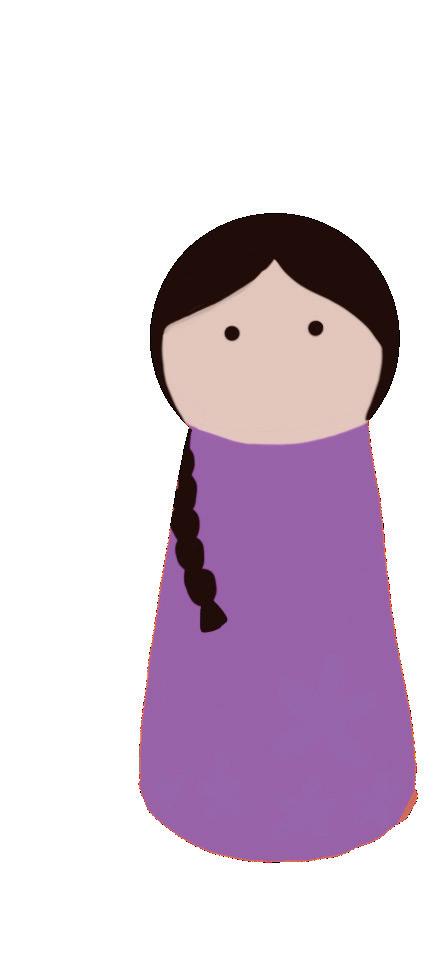
schools to reject the “liberated” curriculum in favor of the state’s model, noting the dangers of using group identity as the primary lens to examine history, society, culture and politics. On the other hand, proponents of the “liberated” curriculum argue that de-emphasizing systems of power and oppression detracts from ethnic studies’ original purpose, leading to surface-level, non-critical explorations of culture and race.
According to Lopez, PAUSD has partnered with the University of California, Berkeley’s High School Ethnic Studies Initiative — part of its History-Social Science Project — starting this year. Some community members have expressed concerns about this partnership, as the group lists the Liberated Ethnic Studies Model Curriculum as a teaching tool and also worked with the Oakland Unified School District, in which a faction of the Oakland Education Association participated in an unauthorized pro-Palestinian “teachin.”
In a Jan. 19 email obtained by The Oracle through the California Public Records Act, Austin clarified to the PAUSD Board of Education that the Oakland teachers union failed to follow standard processes and taught lessons that weren’t connected to the Berkeley consultants.
“During the (curriculum development) process we will consult with a lot of people,” he wrote. “That should be what is expected. There will be many efforts to silence voices, starting with who we even speak with. I am asking that we continue to share the process and timelines and that our board helps people who reach out to understand that we have identified input opportunities.”
In PAUSD, Gunn Social Studies Instructional Lead Jeff Patrick said that though some lesson outlines from the state’s model curriculum may be used, most would be generated by Gunn and Paly teachers. He also noted in an email that it would be “extremely unlikely that (the district) would use anything specific from the Liberated Ethnic Studies group.”
In order to prepare for the 2025-26 course rollout — which was pushed back one year to allow for further course development — PAUSD formed its Ethnic Studies Committee last school year, comprising Lopez, Patrick, Paly Social Studies Instructional Lead Mary Sano, and other Gunn and Paly teachers.
The committee is currently refining the course’s five core units: Identity; Race and Ethnicity; History and Migration; Language, Culture, Education, and Learning; and Action and Civic Engagement. It is also soliciting feedback from students and community members. At the Jan. 30 meeting, the committee announced a new Unit 0: “Why Ethnic Studies?,” and Lopez noted the possibility of one section of ethnic studies running at each high school next school year to allow for additional fine-tuning before the final rollout.
Thus far, alongside the two community meetings, Paly and Gunn held information and student-feedback
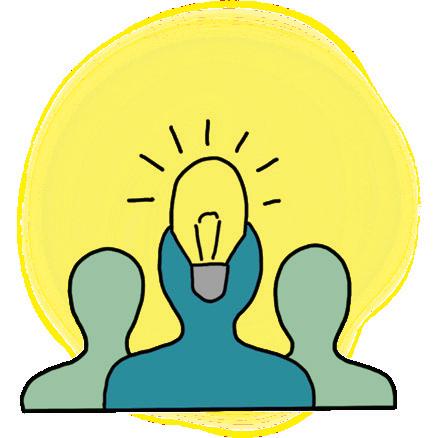

Sept. 13, 2016
sessions during PRIME on Oct. 11 and Oct. 18, respectively.
At the school-board level, community members have advocated for an ethnic studies course encompassing more ethnic groups — mirroring the activism that led to the state’s sprawling model curriculum.
During Open Forum on Nov. 14, 2023, 17 Middle Eastern and North African community members spoke about their experiences with Islamophobia and advocated for MENA inclusion in ethnic studies. According to Paly senior Mariam Tayebi, who is the MENA Club co-president, the group felt compelled to speak after facing bullying and discrimination following the start of the Israel-Hamas war.
“We decided that it’s really important for us to show the district and show whoever else watches (the Board meetings) that there are kids here and we are struggling and we want to be represented,” she said.
At the next meeting, on Dec. 12, eight Jewish parents and students — including PAUSD parent Linor Levav — detailed personal experiences of antisemitism and asked for Jewish voices to be included in the ethnic studies curriculum. Although Jewish Americans’ history is typically not covered in most college-level ethnic studies courses — they are considered white in the context of the discipline — the California model curriculum includes lessons on Jewish Americans and antisemitism.
Although much of the conversation surrounding ethnic studies has revolved around Jewish and MENA curricular inclusion, Patrick emphasized that the Israeli-Palestinian conflict would not explicitly be covered in the new course, and that it’s currently a part of the sophomore Contemporary World History class.
“The scope that the state intends for the ethnic studies curriculum is narrower than the general public … is aware of,” he said. “By the time students are there in 10th grade looking at that topic, they will have hopefully developed the skills or began to develop the skills to analyze those things on their own.”
Paly senior Alma Samet — who identifies as a Mizrahi Jew (Jewish people who are of MENA origin) — agrees with this assessment, noting how including the conflict in ethnic studies could exacerbate misrepresentation.
“I really could see it just overriding and taking up a lot more space in the curriculum than it has to, especially when there are so many different topics and communities to focus on,” she said.
Still, senior Deena Abu-Dayeh stressed the imperfections of how the Middle East is currently covered in Contemporary World History, citing her own experiences.
—Parent of PAUSD alumni Lori Meyers ” “
“I want to ask you to please include Jewish Americans in our ethnic studies class,” Levav said during Open Forum. “Antisemitism has exploded across the United States and the Bay Area. It’s fueled by lies about Jews and Israel. PAUSD can and should help to correct this.”
Beyond specific ethnic-group considerations, many have advocated for transparency with the curriculumdevelopment process.
“It’s very, very important that there is … full transparency,” Meyers said. “The more that the community and students and parents can see what’s going on in ethnic studies, the better and smoother the process is going to be, and the more likely it’s going to be that we get the kind of ethnic studies class that I think we all really want.”
While Patrick understands the community’s desire to participate and the need for PAUSD to share updates and solicit feedback, he emphasized that the lack of transparency some feel can mostly be attributed to educators’ newness to the process, not ulterior motives.
“What we’re trying to do is create a course that’s going to be best for our students,” he said. “So as people are looking at our work and bringing up their own points, I hope that they can keep that in mind that some of the comments parents make might not be in the best interests of our students as a whole.”
Along a similar vein, though PAUSD parent Uzma Minhas also values transparency and community involvement, she cautions the district from only listening to the loudest and most organized groups.
“They have to be very careful that oftentimes marginalized communities don’t speak up, so they may not be hearing from the most marginalized communities,” she said.
Aug. 12, 2019
California Board of Education President Linda DarlingHammond announces that the commission will be submitting a new draft to the Board, citing ideological concerns.
Former California Gov. Jerry Brown signs A.B. 2016, mandating the development of an ethnic studies model curriculum.

“The only time I’ve ever heard (about) Palestine — which is where I’m from — is when it had to do with the conflict and how we are the terrorists, and that name has been portrayed on us a lot,” she said. “That kind of gives a false image that all of us are just barbarians that have to deal with poverty.”
According to Patrick, the ethnic studies course’s final unit — Action and Civil Engagement — will include a capstone activity allowing students to have more choice in the topics that they delve into.
Looking ahead, the social studies department plans to identify potential ethnic studies teachers by this spring, so that it can spend the next school year in professional development related to the course. Although specific trainings have yet to be finalized, teachers will be focusing on developing common understandings of sociological terms that may not be as prevalent in other history classes, “dominant and counter narratives” and “intersectionality.”
Ultimately, despite the complex and oftencontroversial process, Samet maintains an emphasis on the course’s central objective.
“I think the main goals are just to create more well-rounded, respectful students who are ready to go into a world that is very diverse,” she said. “Especially in America, it’s a big old melting pot, so making sure that people maintain respect for all types of cultures and traditions and also understand a bit more of a backstory on the struggles that these communities have faced.”

The next ethnic studies community meeting will be conducted as a webinar, and the district will ask for questions in advance. More information will be provided in Dr. Austin’s weekly Superintendent Updates.

March 18, 2021
The State Board of Education adopts a 688-page model curriculum for high schools.
Oct. 8, 2021
California’s A.B. 101 requires an ethnicstudies course graduation requirement for all public and charter high schools.
—Compiled



Sports are deeply ingrained in society as forms of entertainment, socialization, unity and pride. The Super Bowl, the World Cup and the NBA finals bring millions of fans together to experience the drama and spectacle of peak athleticism. Despite positive benefits and traditions — beloved stadium tacos, Super Bowl Sundays and foam fingers — these games also sport an extremely dangerous side. As overzealous fans spiral out of control, destructive incidents ensue: The Boston Red Sox fans overturned a car following their 2013 World Series win, Kentucky Wildcats basketball fans set fires to couches and trash cans after a tournament loss, and, most recently, the Kansas City Chiefs’ parade saw a mass shooting after its 2024 Super Bowl victory. But this destruction surrounding major sporting events extends beyond the public sphere: Major sporting events are correlated with rising rates of domestic violence.
“Usually, people are drinking lots of alcohol, either at the games or at home watching it, and alcohol is going to make people make very dumb choices.
AP Psychology teacher Warren CollierAccording to the Centers for Disease Control and Prevention, one in three women and one in four men report experiencing severe physical violence from an intimate partner in their lifetime. While most identifiable causes stem from drastic changes in life circumstances and generational abuse, empirical evidence points to other factors that can increase the likelihood of a dangerous home environment — including sporting events.
One report of such violence took place during the 2023 Tubi Super Bowl commercial. The advertisement begins with the game commentators giving a play-by-play of the field, seemingly marking the end of the commercial break. Then suddenly, a menu bar rises up on the screen, and an option is “clicked” as the screen jumps to the streaming service Tubi. Afterwards, on Reddit, a woman shared that her boyfriend became furious at her, believing she “clicked” on Tubi and caused him to miss a portion of the game. He then punched a hole in the drywall.
After the post garnered other women’s attention, many came forward with their experiences, including dozens of bartenders and waitresses who were yelled at and hurt by drunk patrons at their establishments. In fact, alcohol — according to Advanced Placement Psychology teacher
Warren Collier — is the most significant situational force to be examined when considering a spike in domestic abuse on game days.
“Usually, people are drinking lots of alcohol, either at the games or at home watching it, and alcohol is going to make people make very dumb choices,” he said. “And that can lead to things like violence.”
Besides increasing the frequency and severity of the violence inflicted, alcohol harms victims in another way by masking violent behavior. Even though alcohol is a factor, it is never the underlying cause for violent urges, according to the Alcohol Rehab Guide. Many lawenforcement officers, perpetrators and even survivors, however, don’t see it that way. They diminish the crime by painting the narrative of an alcohol-fueled single-trigger accident. This misconception effectively sidelines victims’ experiences and absolves perpetrators of responsibility, concealing the disturbing pattern of violence and allowing it to continue.
Emotional “spillovers” also contribute to these incidents. According to Collier, immense emotional arousal from one situation can “spill over” into other intense emotions after the fact.
“So let’s say I’m really excited that our team won, and I’ll stay happy about it,” he said. “But if my team loses, now I’m upset. And I have lots of physical arousal, like my heart is beating fast and I’m really excited. So now that excited feeling turns into anger and rage, and if I watch the game at home with friends or family, then unfortunately, the target of that rage might be other people.”
Indeed, wins and losses, when different from game predictions, determine the size of fluctuation in domestic violence. According to a study from University of California economics professors David Card and Gordon Dahl, which drew on data from NFL games and the National Incident-Based Reporting System, “upset losses” — unexpected home-team losses — led to a 10% average increase in the number of police reports of athome male-on-female intimate partner violence.
On the other hand, there was found to be no difference in violence when the home team lost after a prediction of a close game or when the home team had an unexpected win. This evidence serves as an important indicator in crime patterning because it suggests a crucial asymmetry in the reaction of unanticipated losses and gains – an unwelcome result of the volatile mix of alcohol, hegemonic masculinity and televised sports.
This pattern of domestic abuse, however, is not exclusive to NFL games. U.S. researchers at Lancaster
University in England studied family violence rates during the 2002, 2006 and 2010 World Cups, discovering that domestic-violence reports rose by 38% when the English national soccer team lost and 26% even when they won. There was also a 11% rise the day after an England match, regardless of the outcome, suggesting the spillover effect.
Even though Palo Alto hasn’t charted a trend between major sporting events and domestic violence reports, according to Palo Alto Police Department Captain Zach Perron, domestic violence itself is still prevalent.
“Domestic violence, unfortunately, is not an uncommon crime in Palo Alto,” Perron wrote in an email. “It’s important to note, though, (that documented) reports and calls reflect only incidents when police are notified. Unfortunately, it is likely that a lot of domestic violence goes unreported to police.”
It’s important to note, though, (that documented) reports and calls reflect only incidents when the police are notified. Unfortunately, it is likely that a lot of domestic violence goes unreported to police.
Palo
Alto Police Captain Zach PerronMoreover, fan behavior continues to be a local concern: In August 2023, two Bay Area high school games ended due to fan violence, and on Feb. 13, Gunn’s basketball senior night ended in an altercation between adult spectators.
Given the pervasiveness of family violence, resources have been designed for victims, such as domesticviolence shelters in Sunnyvale that allow up to a 30-day stay and 15-day extension for emergency shelters. Perron also urges victims to contact the police station or visit the PAPD website.
Ultimately, though, domestic abuse is not fundamentally inspired by external factors such as alcohol or the vehemently passionate environment of sporting events, but rather a need for a perpetrator to regain a sense of control over their partner. To give these situations the attention they deserve, there must be a continual willingness to support victims of this circumstance in order to end the normalization of family violence.
—Written by Kaylee Cheng
Have you witnessed someone have a strong emotional response when watching a sports match?
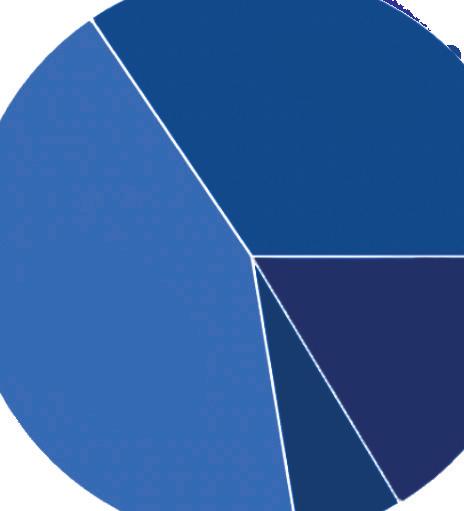
The Palo Alto Police Department encourages anyone in a domestic violence situation to call 911 if it is an emergency, or the PAPD’s 24-hour dispatch center at 650-329-2413.
accordion.

It’s a classic image: fans on one side of the stadium screaming for their school while the other side chants for theirs. The players are deep in the game, both sides hoping to emerge as the champion and bring the coveted title to their side of town.
Although the local rivalry between Gunn and Paly doesn’t quite bring this level of drama — barring incidents like September 2022’s football game, which was canceled due to student misbehavior — Gunn athletes find that it has its own intensity and competitive spirit.
When it comes to basketball, boys varsity team co-captain senior Ethan Fu feels that the larger crowds that rivalry games attract create an immense pressure to win.
“The crowd is always huge (when we play) Paly, and it’s disorienting at first,” he said. “But the pressure from the crowd isn’t just pressure to represent my school, but also pressure to show (up) for my friends and family who are there watching me.”
Varsity point guard junior Sam Little also highlighted the benefits of playing to an audience.
“The fan turnout definitely makes our team play better,” he said. “It keeps us alert and more in touch.”
Although Little acknowledges the idea of home-court advantage, he believes his wins and losses mean more when they happen at Paly.
“Especially when we play Paly at their home court, there’s this feeling of, ‘I want to crush this team in front of their own support, on their own home turf,’” Little said. “Above all, the game just feels more competitive.”
Both Fu and Little also emphasized how being the underdogs — Gunn is usually projected to lose matchups against Paly — imbues a game with extra emotional charge. While Paly has to defend their previous wins, Gunn is able to fight from the bottom up.
“When we win, it’s especially gratifying,” Fu said. “(It) feels like we’ve beaten the odds.”

Girls varsity lacrosse team member junior Sophia Howell finds an opposite dynamic to be true for her team, which has won every game against Paly since the 2021 season.
“Most of the pressure the team faces when it comes to playing Paly is around maintaining our winning streak,” she said. “But at the same time, having wins behind us alleviates pressure while playing.”

According to Howell, there isn’t much of a difference in crowd size when their team plays against Paly, so spectators don’t play a role in raising the stakes.
However, similar to the competitiveness the Gunn boys basketball team brings as the underdogs, Paly girls varsity lacrosse brings its own spirit, fighting to break Gunn’s “We play a pretty clean game and tend to keep our cool (as a team), but when Paly is
sport. Adelman competes in the 400-meter dash and 300-meter hurdles — both non-contact, individual events — which present a new kind of competition.
“For track, it’s less about racing your opponents and more about racing for time,” Adelman said.
Even so, she found that competing against Paly with the rest of the varsity girls team brought them together in a special way.
“In the last season, varsity girls beat Paly and we were all so excited on the way home,” Adelman said. “It definitely would’ve been a different feeling if we beat (another high school) or something, but we beat our cross-town rivals, However, the cross-town rivalry runs deeper. Last season, Paly runner Hillary Studdert — who is the sister of this article’s author — was one of Adelman’s biggest
track-and-field member senior Avery Adelman, the Gunn-Paly rivalry manifests itself differently

“In the 400(-meter dash), Hillary had times that were similar to mine, so I was always really nervous before we (met) with Paly,” she said. “I was also just really excited to race because I knew she would push me to run a fast time whether she beat me or not. It was all good energy and she was a great
Adelman feels that the local aspect of the rivalry makes the competition more personal.
“The girls who I run against from Paly, I’ve mainly ran against before,” she said. “We get to talk here and there, so there’s always a kind of sense that I know who I’m running against, which makes me want to compete harder.”
Fu also finds a sense of familiarity among his Paly
“A lot of the kids that I grew up playing club basketball with now play for Paly, so I’m friends with basically the whole team,” he said. “It adds a mix of intensity and fun, which you can’t find really with any
—Written by Vivian Studdert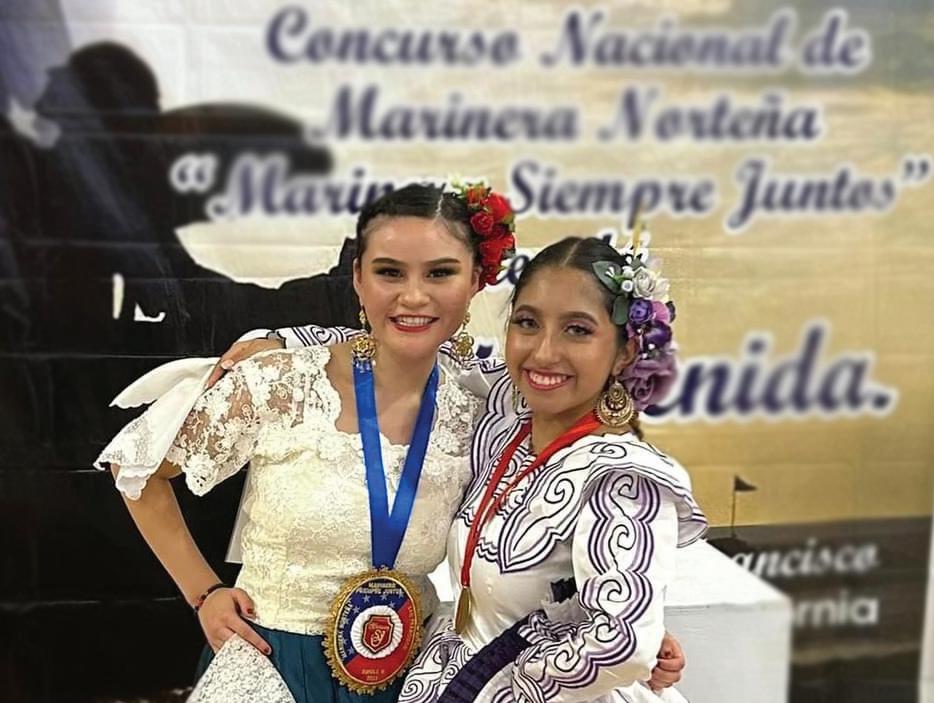

Sophomore Megumi Estrada Nakamatsu has been participating in Marinera Nortena, a traditional Peruvian dance, since the age of 6. Marinera Nortena originated in Trujillo, Peru, and is a couples dance that tells a story about a man trying to court a woman. The female dancer traditionally dances barefoot in a custom dress while the male dancer wears a straw hat, suit and poncho. Currently, Estrada Nakamatsu practices at the Veterans Memorial Senior Center in Redwood City after hours.
Estrada Nakamatsu’s parents first introduced her to the Marinera to help her and her sister connect to their culture. Although Nakamatsu sometimes disliked attending practices, she eventually grew to love expressing her emotions and culture through dance.
“I was the only Peruvian at my elementary school for around four years, which made me feel very isolated and scared to represent my own culture,” Estrada Nakamatsu said. “It was kind of hard to try to accept my culture and be proud of it (because of) the really deep seated fear of being judged. As I got older, I definitely started to become more proud of my culture. Now, I’m very open. I love to show it off.”
Through the Marinera Nortena community, Estrada Nakamatsu surrounds herself with people who share her Peruvian culture, giving her a sense of belonging. The excitement that comes with dancing gives her an opportunity to cherish her culture.
“Sometimes, I’m so focused on the excitement of the dance that I block out the cheers of my family and I’m completely in a state of happiness,” she said.
Estrada Nakamatsu participates in several competitions during the year, though schoolwork and parent availability limit the number of practices and competitions she can attend.
“I was really happy to be (at the Marinera Siempre Juntos competition in January) because I hadn’t competed in such a long time,” she said. “I got a lot of compliments, and it felt really good to be in traditional wear.”
Competitions usually consist of three pairs dancing while four to six judges watch, with multiple rounds if necessary. Pairs are judged based on the spontaneity (the personality of the dance), grace, coordination and zapateo (the footwork).
Through these competitions, however, she’s had to face the hard truth that certain dancers pay to win, even at the major national championship in Peru.
“It’s clear when someone who wins first place only won because they paid or because the judges weren’t good at deciding,” she said. “Sometimes it gets super frustrating that you just want to cry, because you’ve worked so hard and you have so much experience just to lose against someone that isn’t as experienced as you are.”
Despite this challenge, Estrada Nakamatsu continues to dance at competitions and for her own enjoyment.
“I basically just want to have fun,” she said. “I love to represent my culture. One day, I want to maybe even go to Gunn in my traditional clothing that I dance with to be able to show it off and be able to see other people wear (their) traditional wear.”
—Written by Sophia Hwangbo
From Hermione in J.K. Rowling’s “Harry Potter” series to Starr Carter in Angie Thomas’ “The Hate U Give,” empowered women have become increasingly prominent in literature. This development, however, is fairly recent, as women have historically been excluded from creating and starring in narratives.
Traditionally, female narratives center around service, obedience and helplessness. The push for a more diverse, equitable and truthful depiction of women has turned a new page in the history of literature.
Representation in literature depends on representation in authorship.
According to a 2023 paper by American economist Joel Waldfogel, in the 19th century, only 10% of books in the Library of Congress had authors with female first names. While this measure does not account for female authors who — like George Eliot — used pseudonyms to disguise their gender, the disparity remains stark: The maledominated field resulted in books that mostly included male perspectives, in which women were only secondary

These pieces of literature are now part of the American literary canon, which comprises the works deemed highest quality and most important, such as “The Great Gatsby” or “1984.” English teacher Paul Dunlap tries to subvert this trend in his classroom by teaching a mix of canonical
works and more female-centric novels.
“What I used to call ‘the canon’ was pretty malecentric and women were peripheral characters,” he said. “I think we’re doing a better job inviting people to read stories that put women as central characters.”
This idea is mirrored in American literary historian Cynthia Griffin Wolff’s “A Mirror for Men: Stereotypes of Women in Literature,” in which she explores themes that seem missing from most historical literature, including motherhood and marriage (or the choice not to), private life, loss of beauty and menopause.
Instead, women are only caretakers — mothers, sisters, wives — or love interests. In Fyodor Dostoyevsky’s “Crime and Punishment,” for example, the female characters all fall under either one of these categories and interact with other characters within the confines of these roles.
More multifaceted and truthful depictions of women started appearing on a larger scale in the 1970s. English teacher Tarn Wilson, who is also a published author, notes that during this time period, a major gender shift in the publishing industry paved the way for better representation of women: According to Waldfogel, the number of female-authored books in the Library of Congress reached 18% by 1960.
Since the early 2000s, books aimed at teenagers have changed dramatically, as have their demands, leading to more accurate characterizations of women. The 2000s saw a revival of the science fiction and fantasy genres in young-adult fiction. These novels included strong-willed, powerful female protagonists.
Published in 2008, Suzanne Collins’ “Hunger Games” trilogy features Katniss Everdeen, a young woman, fighting against an oppressive government. “The Hunger Games” trilogy was an instant hit, initiating a trend of dystopian novels
in which women save their worlds, such as the “Divergent” trilogy by Veronica Roth and “Shatter Me” series by Tahereh Mafi.
While these series do contain strong romance arcs, they portray women as more than just caretakers or secondary characters. They are now the protagonists of their own story, making hard decisions and showing an array of emotions.
Senior Fiona Li has seen a growing trend of fleshedout female characters, with titles such as Alice Walker’s novel “The Color Purple” and Abraham Verghese’s novel “The Covenant of Water” rising to the fore.
“Now, if you look at best-sellers, YA, romance and others, you see a lot of books with female protagonists where it’s based on their life and there’s not as much emphasis on a love story,” Li said.
Diversity in literature allows nonwomen readers to better understand women’s experiences. American author Toni Morrison’s Nobel Prize speech reflects this idea, according to Dunlap.
‘“Tell us what it is to be a woman so that we may know what it is to be a man,’” he said, quoting Morrison’s speech. “We read literature to empathize with other people, and that’s the only way we can learn about others.”
—Written by Lise Desveaux
As a young girl, Ursula Schnyder found herself in the kitchen, learning recipes from her mother, making weekday dinners or baking desserts during the weekend. In 2013, Schnyder channeled her passion into founding her own Swiss chocolate business, Sweet55, which has locations in Half Moon Bay and Palo Alto’s Town and Country Village.
Although Schnyder wanted to pursue a culinary career as a teenager, she attended university to study history, French and international relations after pushback from her family. Afterward, she entered careers in teaching and foreign journalism.
Her interest in baking and cooking, however, never stopped. After both of her children graduated from high school, Schnyder brought her childhood dream to life, opening a chocolate store to pay homage to where she grew up.
“At that time, I felt I was not young enough to go into a full-fledged career in the kitchen, so I decided to focus on a small area,” she said. “At first, I thought of opening a Swiss bakery, but then I decided to go even more refined into just chocolate because chocolate is such a big part of the Swiss food scene and my childhood.”
In preparation for launching her business, Schnyder attended a professional pastry school for one year in the U.S. before returning to Switzerland to train specifically in Swiss chocolate. Back in the States, she began making chocolates in her home kitchen, curating confections that combined creativity and tradition.
Photographing a huddle of penguins at the San Francisco Zoo at 14 alongside her mother marked the beginning of Kate Skogen’s journey in pursuing photography and later founding JetKat Photo in 2001, where she took on the role of lead photographer.
Growing up with parents who pursued side projects — her mother painted, and her father established a school for aspiring race drivers — and friends who were musicians, writers and artists made starting her own business feel like a natural next step and way to remain close to home.
“Being around other creative people who were all making their own path paved the groundwork (for my business),” Skogen said. “It felt totally normal.”
The name “JetKat Photo” pays homage to Skogen’s childhood living in a sailboat with her father and traveling on the JetKat Express passenger ship while studying in Cuba. The name also connects to the skies: Her father held a pilot’s license, and her mother, a flight attendant, lived in different states.
“I like that JetKat had ‘jet’ in it to symbolize my traveling back and forth to be with my parents, family ties and the love that I have for traveling,” she said. “Lots of friends call me Kat, so the ‘Kat’ part was unique to me.”

“A lot of these pieces are actually my own, inspired by flavors that I knew as a child or what they are doing in Switzerland now,” she said. “It was very important for me to create a product that people would recognize over time as Sweet55, in
Schnyder opened her first location in 2016 in Half Moon Bay and a second in 2022 in Palo Alto’s Town and Country Village. According to Schnyder, the name of her business originated from wordplay on the phrase “Sweet 16,” replacing the numbers with her age when she started. The name now reflects the message of her brand: finding joy

“My daughter encouraged me to bring that into the brand — that what we sell is sweet and also that it’s okay to start something new later in your life and make it sweet,” she said. “When I said that I’m 55, some people are a little embarrassed because in America, you don’t talk about age. Whenever you’re on social media, everybody is young, but I want to bring the age factor into my business because it can encourage other people, other women especially, who may be tired of their other careers and have the desire to start
By providing photography services for school programs, local businesses, town magazines and neighborhood families, JetKat Photo has become more than a source of income for Skogen. With her passion for capturing who people are and their works, she finds fulfillment in illuminating the stories and contributions of community members.
“If I’m not photographing a person specifically, I’m photographing their architecture, kids, art, product or restaurant,” she said. “With the work that I do, there’s always somebody who benefits and whose work is celebrated and elevated. It’s rewarding in ways I couldn’t have foreseen.”
At the heart of her business is Skogen’s profound passion for capturing the unscripted and spontaneous moments of children immersed outdoors, where all of her photos emanate a playful, earthy and dynamic feel. Today, Skogen’s portraiture program is most involved at the elementary-school level and specializes in candid portraits for nature-based school programs and homeschool groups.
“My favorite thing to photograph is the authentic essence of outdoor education programs and kids playing in nature and looking for bugs,” she said.
Skogen proudly donates 25% of her gross sales to local nonprofits focused on education or racial and social justice. She also champions another cause: being a model of women’s entrepreneurship.
“I think that representation matters and when women see women doing things, there is a ripple effect,” she said.


Over the past two decades, Stan Lee’s iconic comic-book characters have been transformed into beloved and inspiring superheroes on movie screens. Marvel Studios has also earned praise for its connected plotlines and creative storytelling. In fact, according to data from Rotten Tomatoes, a film-review site, six of the world’s 20 highest-grossing films ever have been produced by or in association with Marvel.
However, after the end of the Infinity Saga — 23 movies strung together pitting “The Avengers” against the looming threat of supervillain Thanos — Marvel has struggled to find direction and purpose with its new projects.
While the studio has produced successful films in the Multiverse Saga, such as 2021’s “Spider-Man: No Way Home” — which accumulated over $1 billion in the box office and received a 93% critical rating — many viewers have noticed and criticized the lower quality of more recent projects. Two of the three Marvel films released in 2023 received relatively low critic and fan ratings. According to Rotten Tomatoes, “The Marvels” garnered a 62% critical consensus while “Ant-Man and the Wasp: Quantumania” received a mere 46%. Conversely, 2017’s “Thor: Ragnarok” received a 93% and 2018’s “Black Panther” attained a 96%.
While English teacher Terence Kitada, who worked as a Marvel intern in 2007, believes that multiple plotlines branching out with no clear connection is contributing to the films’ decline in popularity.
“(Currently, there are) these weird and disconnected storylines,” he said. “In the Infinity Saga, it’s all building towards one story, and so (there was) a clear story arc. Now it’s
like, ‘Oh hey, here’s “The Eternals” if you want that, and here’s “Shang-Chi” or “She-Hulk.”’ Do they connect? ‘No, but let’s just keep on making things and see what happens.’”
Senior Jeri Lieberman-Evans believes that Marvel’s historical popularity is difficult to maintain after multiple successful projects with many different plotlines and characters.
“Part of (the decline) could be the general opinion is changing because Marvel is such a big film franchise,” she said. “When they make good movies, they’re overhyped and when they’re bad, like ‘Morbius,’ they get overhyped in the other direction.”
Furthermore, Marvel’s traditional role as the superhero trendsetter, coupled with its release of mediocre films and television shows, has contributed to a phenomenon called “superhero fatigue.” Though Marvel set a high standard with several blockbusters, recent declines in its films’ overall quality have exhausted cliches and are beginning to wear out fans and viewers.
Since the finale of “Avengers: Endgame” in 2019, there have also been departures of multiple actors at the heart of the franchise, including Chris Evans (Captain America), Scarlett Johansson (Black Widow) and Robert Downey Jr. (Iron Man). The legacies of these actors are etched into Marvel’s history, and the studio has had difficulties establishing new central characters since.
While Marvel has not been successful in box offices recently, there is time and hope for the franchise to return to its previous success. Indeed, some of Marvel’s staple attractions remain: Marvel Club President senior Kaitlyn Gonzales points to the franchise’s ability to transport viewers to fictional worlds.
“I feel like the characters have a lot of versatility when it comes to putting (fans) in their position or identifying with them,” she said. “(The franchise) also serves as an escape from reality. In everyday life, you’re not going to face a supervillain that has powers.”
With the highly anticipated release of “Deadpool & Wolverine” this sum mer, Marvel will look to reset and transi tion the franchise into a new phase.
“There’s still an ap petite in the sense that people still watch (Marvel) mov ies,” Kitada said. “How ever, (Marvel writers and directors) have to find a different way to cap ture the audi ence or go in a different direc tion.”
—Written by Ellie Yuan Karis Lau

The long-awaited TV show “Percy Jackson and the Olympians,” first released on Disney+ in December 2023, received over 10 million views in its first week. In the same month, the movie “Wonka,” remake and prequel to “Willy Wonka,” hit the screens, ending the year as number one in the box office. Finally, in February 2024, the live-action remake of “Avatar: The Last Airbender” aired on Netflix, gaining 153 million watch hours within its first week after release.
The past few years have seen an upsurge in film or visual-media counterparts to popular childhood book series. Junior Stella Su remembers watching several older adaptations of her favorite childhood books — including “Harry Potter,” “The Giver” and “James and the Giant Peach” — and thinks adaptations may be going downhill.
Composition and Literature of Visual Media teacher Justin Brown said that the rubric for a good adaptation has many dimensions. In his experience, the best and most satisfying adaptations stay true to the original novel: capturing the theme, understanding the characters and imitating the writer’s style.
“In a movie, you need to have conflict in every single moment — otherwise, the audience gets bored,” Brown said. “There needs to be something at stake every moment. And a part of what’s wonderful about books is they just provide a texture to the characters in a way that films can rarely do now.”
Another problem, Brown notes, is that many directors struggle to compress the full depth of a novel into one movie. This notion is shifting, however, as many adaptations such as “Percy Jackson” move away from the movie format and into a multi-episode show.
“Now, so much mainstream entertainment is about serialized streaming stories where they’re going to spend six seasons adapting a book,” Brown said. “Those are situations where you can really do justice to it.”
Su agrees that attempting to cram a large amount of content into a film can ruin the pacing but also notices how adaptations of shorter

books, such as “The Giver,” tend to stretch out unnecessary scenes and include their own details.
Freshman Ofer Kranz, who has read the “Percy Jackson” book series and watched both the movie and recent show adaptations, also appreciates the benefits of a series. She recalls the anticipation she and other fans felt waiting for the first episode to air.
“I forced my parents to watch it,” Kranz said. “It was good, really good. And I thought, ‘Finally, it’s here. Finally, we can breathe.’”
Though there were a few disappointments with pacing and altered scenes, Kranz recognizes that there is no perfect adaptation and recommends the “Percy Jackson and the Olympians” show for its stronger fidelity to the book series than its movie counterparts.
“They looked at more independent details that weren’t really portrayed in movies,” Kranz said. “They did a really good job with the characters and other details so I definitely prefer the series to the movies, but the books will always be on top.”
With these recent adaptations, Su also hopes to see tributes to smaller book series, and underappreciated or newer novels.
“It’s kind of a shame that (companies) usually only adapt books when they get really popular because a lot of times they try to bank on the already existing popularity,” Su said. “And so obviously some good books don’t get adapted.”
—Written by Vanisha Vig




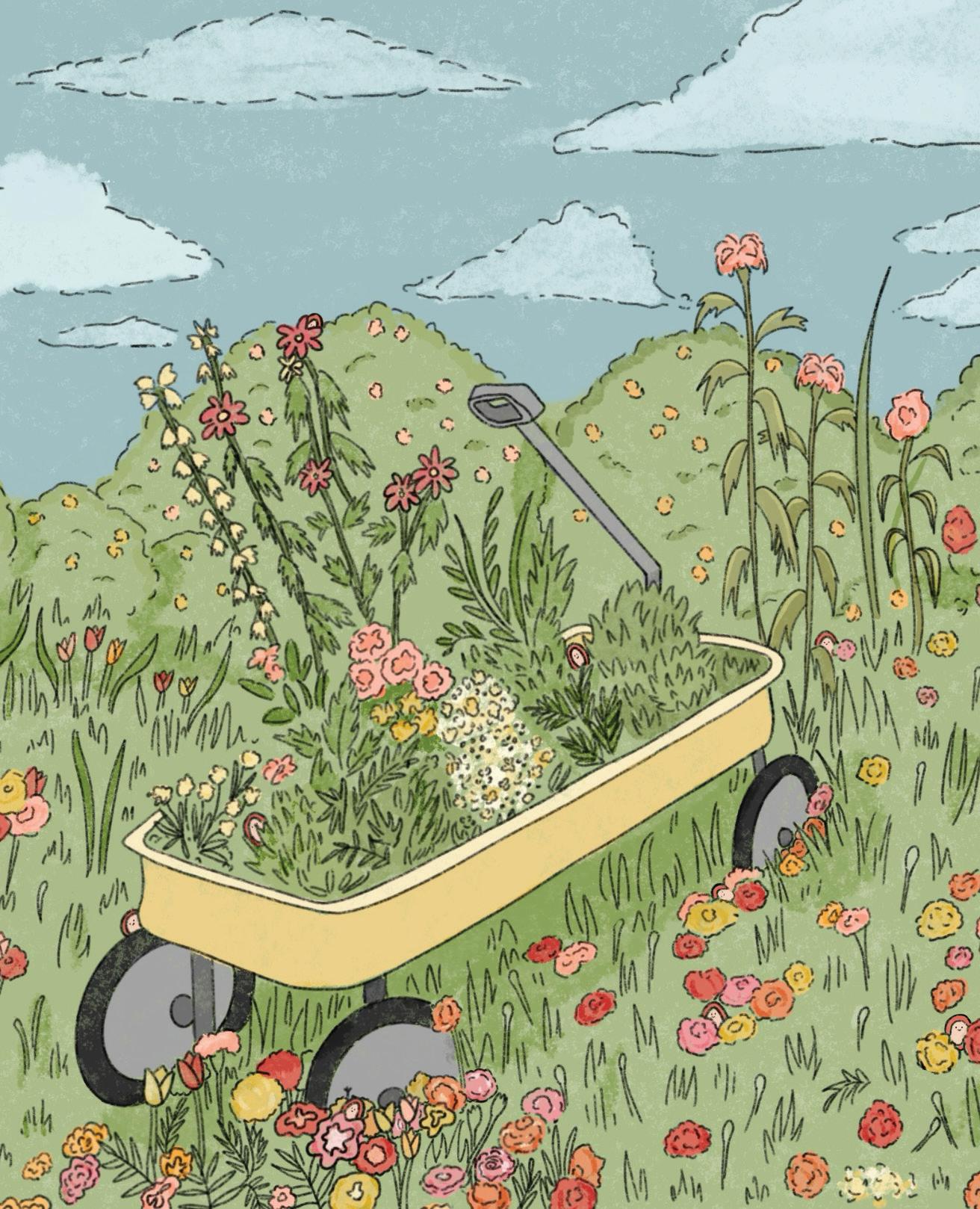



Freshman David Nadberezhnyi started learning Brazilian jiu-jitsu — which emphasizes ground work more than jiu-jitsu — a year ago and has been training persistently since. With the time and effort that he has put into learning BJJ, Nadberezhnyi currently holds a yellow belt at Shiba Fresh Jiu-Jitsu Studio and has become more adept with the strategic thinking the sport requires.
“When I started BJJ, I didn’t even know what it was, but after some time, I got kind of good at it,” he said. “I use my brain and strategy, and I try to see what people are going to do and to think what their next move is.”
BJJ involves repeating various moves, such as the heel hook or the Americana — Nadberezhnyi’s fa vorite — in which the player bends their oppo nent’s arm at a 90-degree angle and pushes the shoulder to the ground.
“I’m usually replicating the same thing, not to be perfect, but to get used to it,” he said.
Other than enforcing discipline, Nadberezhnyi’s instructor, along with his fellow peers, creates a supportive and encouraging environment.
“The people who I train with are super nice,” he said. “We support each other, and we correct each other if a person knows and sees (something) the other one doesn’t.”
Going forward, Nadberezhnyi plans to continue improving his skill level and start participating in competitions.
With his frequent training and support he receives, Nadberezhnyi has immersed himself into his BJJ community.
“For me, BJJ is a great hobby, and it’s a way for me to spend lots of time with my friends,” he said. “The mat we train on feels like a second home.”
—Written by Fiona Xiong

In 2017, sophomore Ryan Panepucci’s uncle introduced him to jiu-jitsu, a self-defense martial art, at Serao Academy. His first time trying out jiu-jitsu didn’t leave a lasting impression, but after his second attempt at it, Panepucci realized that it was the sport for him.


Joining his older brother, junior Hyunchan An began learning taekwondo — a Korean martial art developed in the 1940-50s, influenced by Chinese and Japanese martial arts — when he was 5.
Taekwondo has grown into an integral part of An’s identity. In Korea, An viewed taekwondo more as a hobby, but he began spending over 15 hours a week on the sport after joining his new studio in the U.S., Taekwon Tigers. The studio encouraged him to become involved in competitions.
“Now, I want to do better,” he said. “I want to make sure I get higher rankings, but also just see myself improve as an athlete.”
Instead of sparring, An competes in “poomsae,” a performance of a pattern of taekwondo moves for a score. This focus on form instead of combat gave him a new perspective on the martial art.
“I’m grateful that it’s considered a sport, but it’s also an art with a lot of history,” he said. “Considering that it’s a Korean martial art, it’s a part of my cultural identity and it’s how I communicate with that (part of me).”
According to An, due to the rigid ranking system for the event in the U.S., it is very difficult to surpass competitors with a higher initial ranking. However, he has still managed to climb the ranks.
“(When) I made it to (the national taekwondo junior division) top 10, it felt like I kind of disproved that rigged system and showed that anyone could still make it up there as long as they really invested their time and effort,” An said.
Through taekwondo, An has learned to persevere, focus on making realistic progress and cultivate intrinsic motivation.
“At first, even though I was really bad at it, I just enjoyed it so much that I would do more,” he said. “I would go (to my studio) one to two hours earlier and stay after for another 30 minutes just to do the same thing over and over. It felt like I was doing something that not everyone else would be able to do later in their lives.”
—Written by Violet Tivol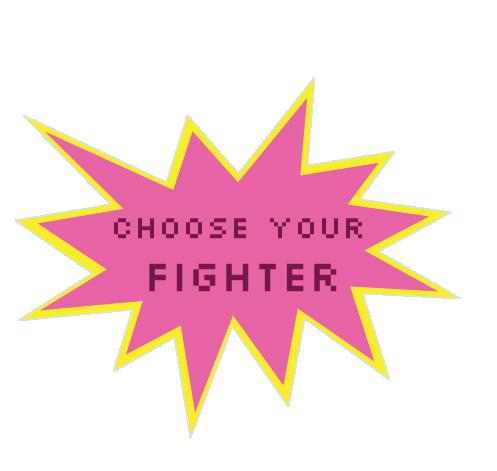
While he was initially inconsistent with his jiu-jitsu training, Panepucci eventually adjusted his lifestyle to prioritize his sport.
“I learned that consistency doesn’t mean I go five times a day and not go for the rest of the week,” he said. “It’s better to go once every day because it’s consistent.”
One of Panepucci’s favorite skills to perform is the Berimbolo, a move from Brazilian jiu-jitsu that entails rolling over, grabbing the opponent’s ankle, flipping them over and grabbing onto their back, or hugging them. After Panepucci saw this technique on Instagram, he wanted to give it a try and asked to practice on his friend at the gym. He soon gained the confidence to perform it in sparring.
“It’s a pretty unexpected move, so I like doing it,” he said.
While Panepucci didn’t originally have much interest in competitions, he still participated because people advised him to do so. Although he, having a white belt, was intimidated by his opponents who had higher rankings, he eventually learned how to stay mentally strong during each match.
“If I have no stripes, I can still beat someone with four stripes,” he said. “(Upset victories) happen a lot, so I learned to not let that get to me and to trust myself.”
Looking forward, Panepucci wants to continue improving his jiu-jitsu skills and focusing on bettering himself.

“I’ve learned to always try and better myself by being better than who I was yesterday, rather than being better than other people,” he said.
—Written by Yueun HongWhen it comes to martial arts, senior Jaein Chung has been around the block. She currently practices Muay Thai, a Thai martial art, and Jeet Kune Do, a martial art created by Bruce Lee and based on the Chinese Wing Chun.

Chung’s journey began in second grade, when her mother enrolled her in a summer fencing program.
“(My mom) was always just encouraging me to try different things,” Chung said. “I always went to a lot of different summer camps. That was just one of them, and I really liked it.”

Chung then dove into the fencing world, sparring competitively for another five years — until she was ready for something new.
“It was very time consuming and I would have had to miss a lot of school,” Chung wrote to The . “It was also becoming more competitive as I continued, and I was slowly losing passion ... But I always found that martial arts were interesting
So, Chung joined a kickboxing class. Although her foray into the sport was cut short by the COVID-19 pandemic, she was interested in the technical side of martial arts.
“Kickboxing (was) not very technique-based,” she said. “It was just supposed to be fun, and I enjoyed that, but wanted to actually learn with real techniques and skills.”
Recently, Chung has joined the Tandez Academy of Martial Arts in Mountain View. Tandez Academy teaches a variety of martial arts, including Jeet Kune Do, Muay Thai and others, with a focus on real-life applications, which she appreciates.
“(Tandez Academy) is always thinking about (martial arts) in the perspective of being in actual combat, like a life or death situation,” she said. “It’s empowering.”


Chung realizes that martial arts can seem scary, but she appreciates what she has learned through “I know it’s kind of scary for some people, but I think it’s cool to be able to know how to protect yourself,” she said.
—Written by Fenton Zarlengo